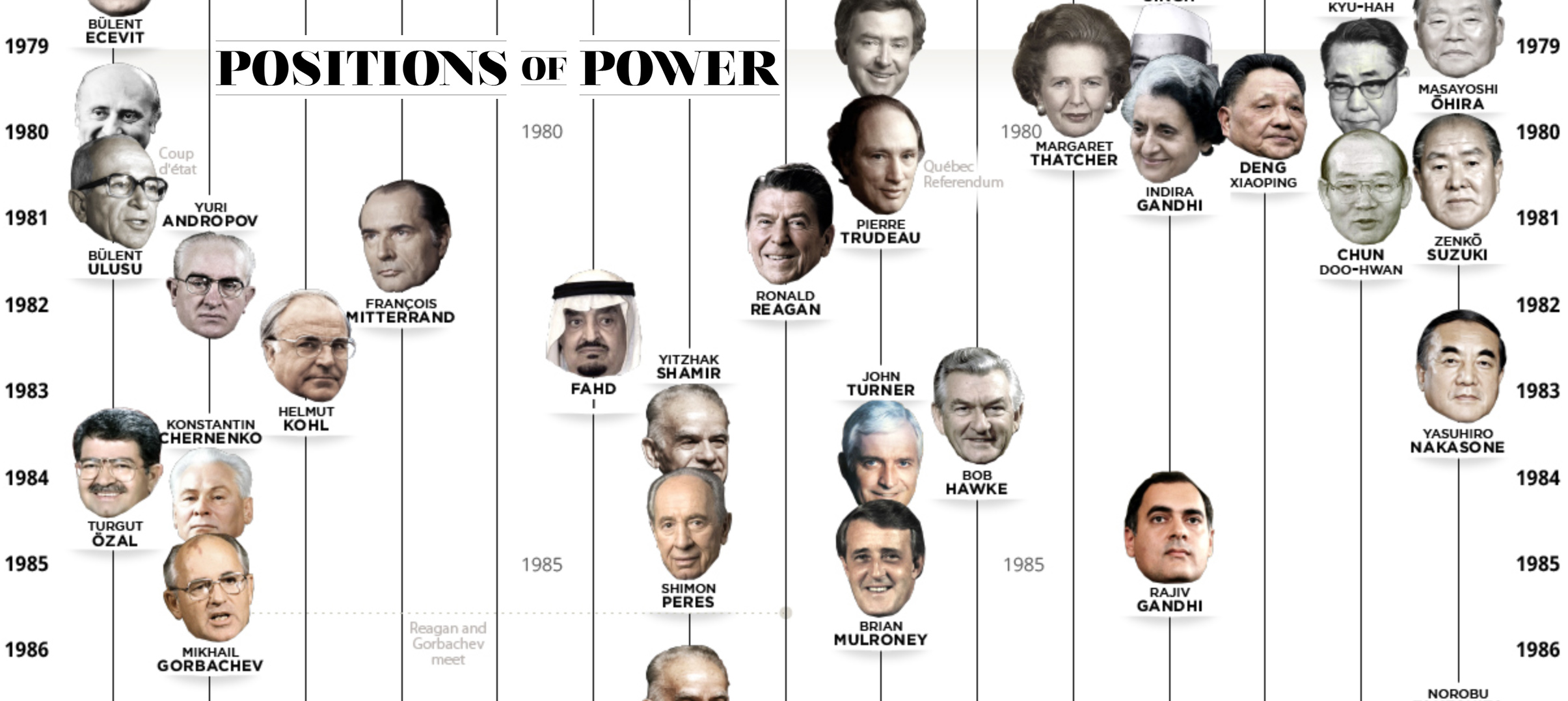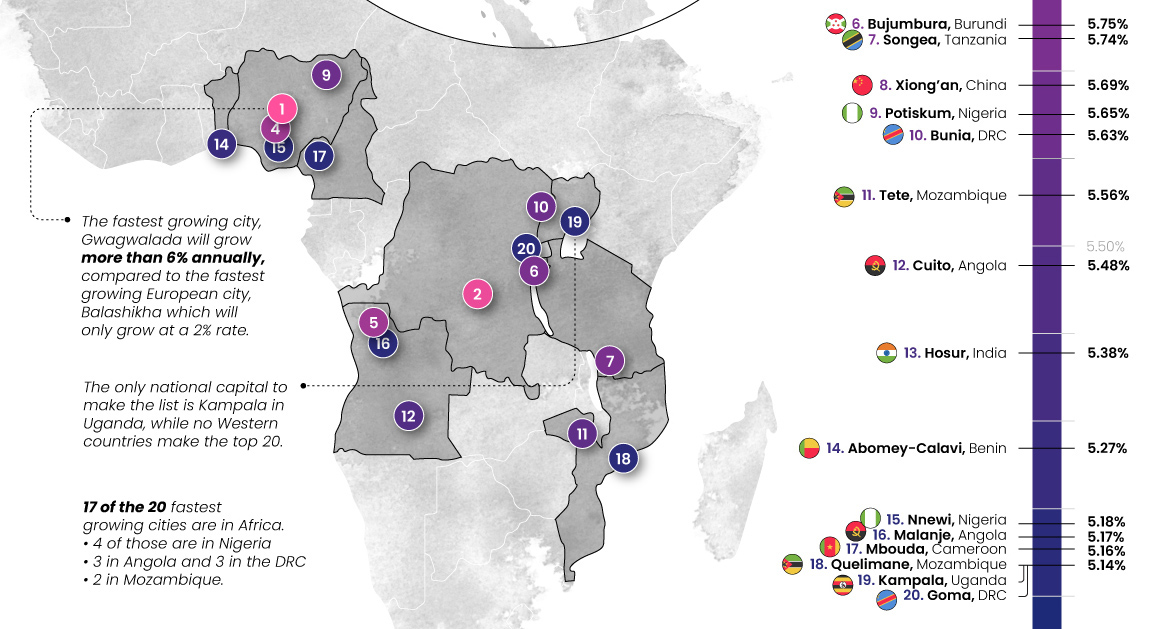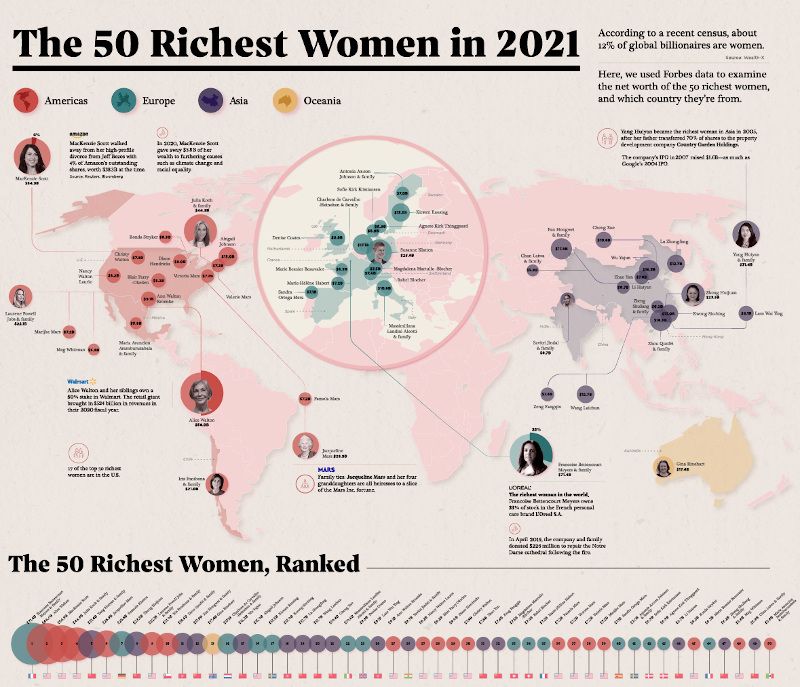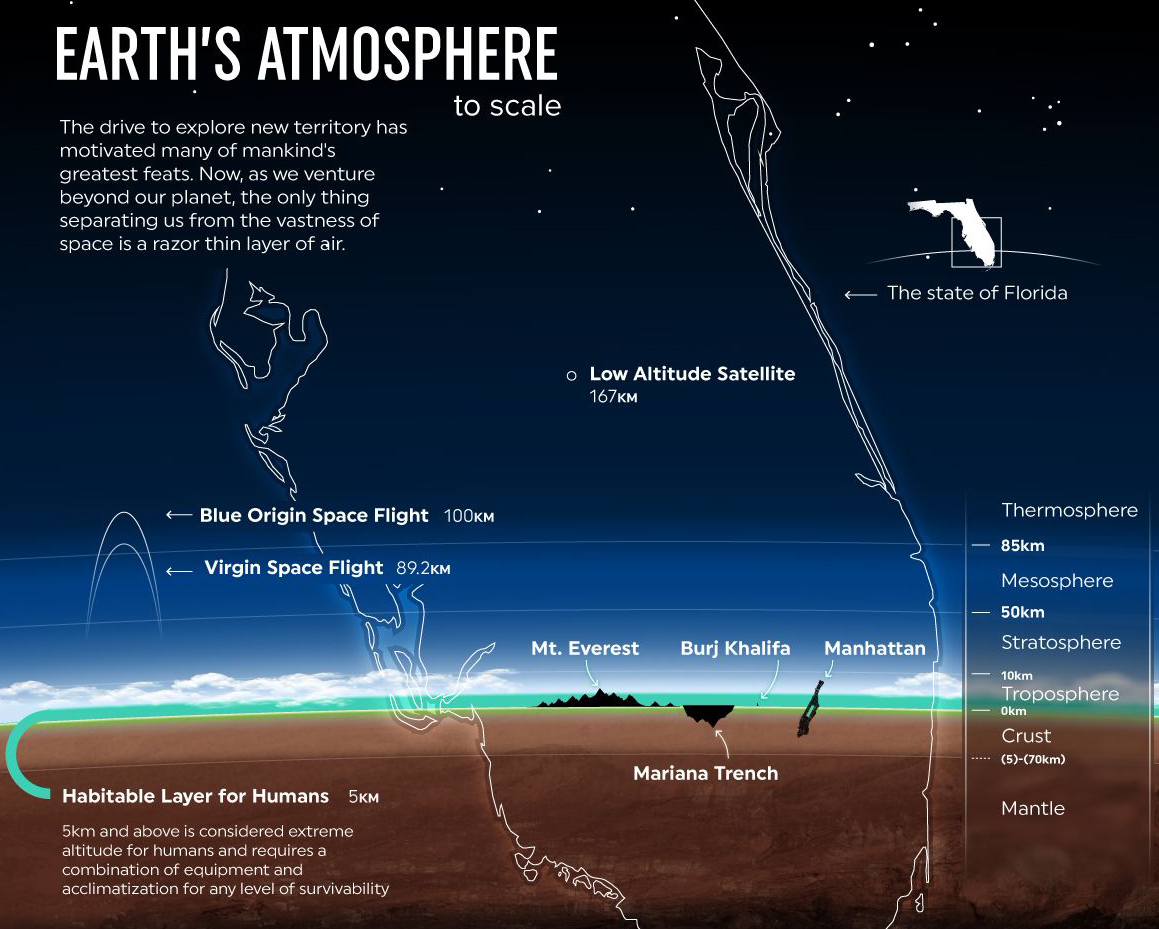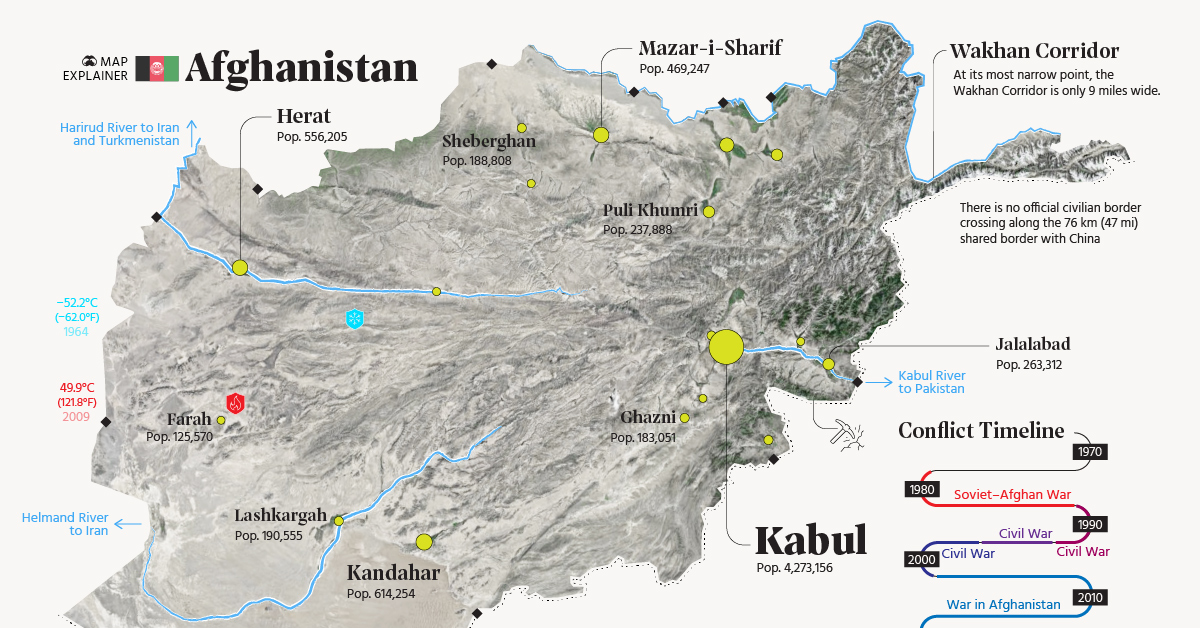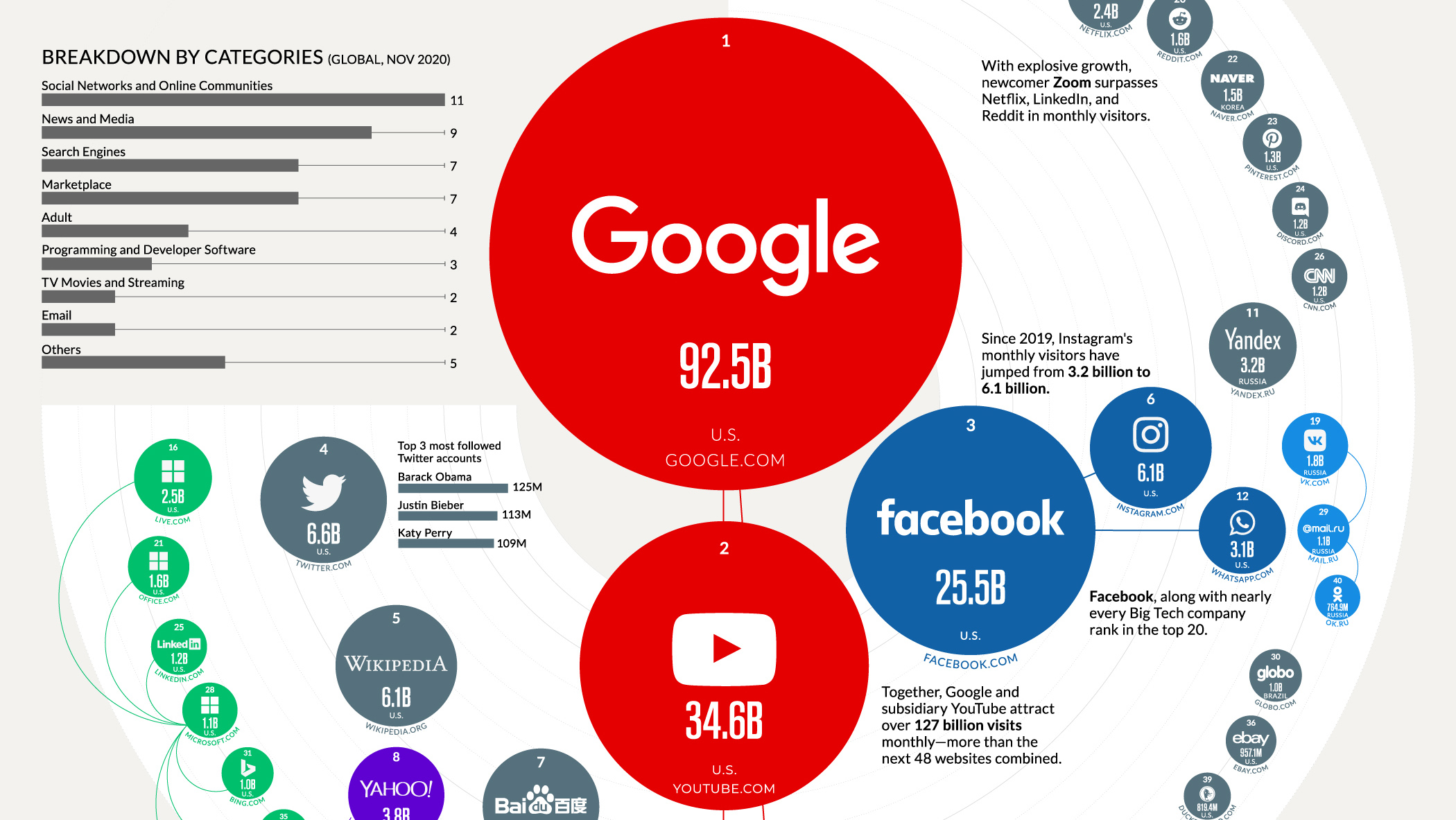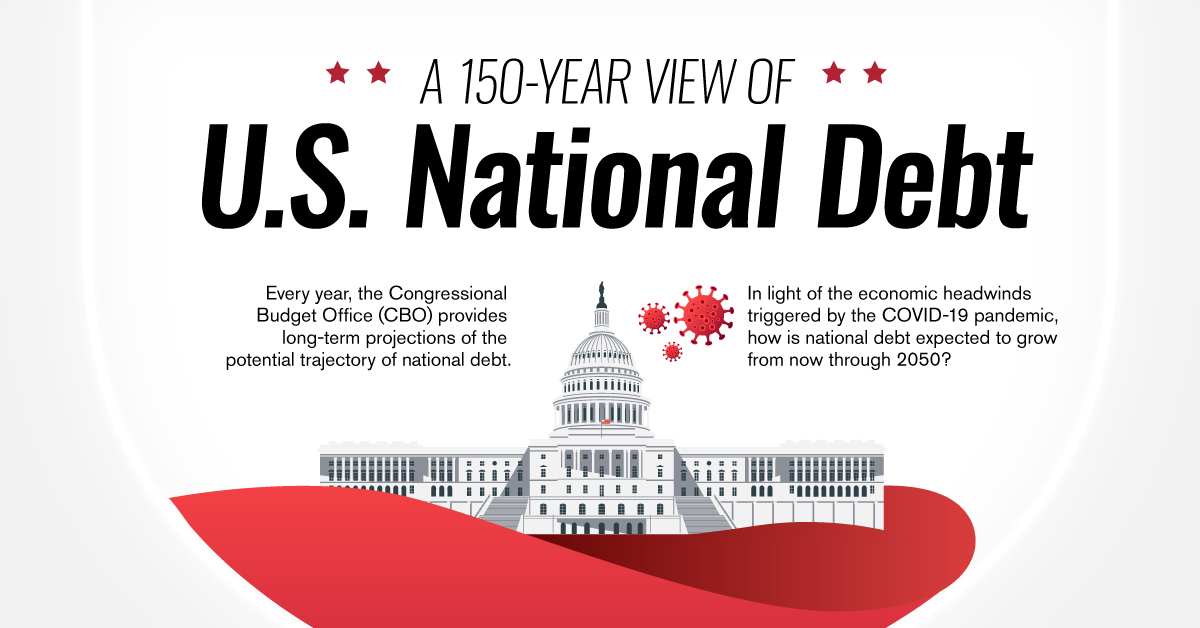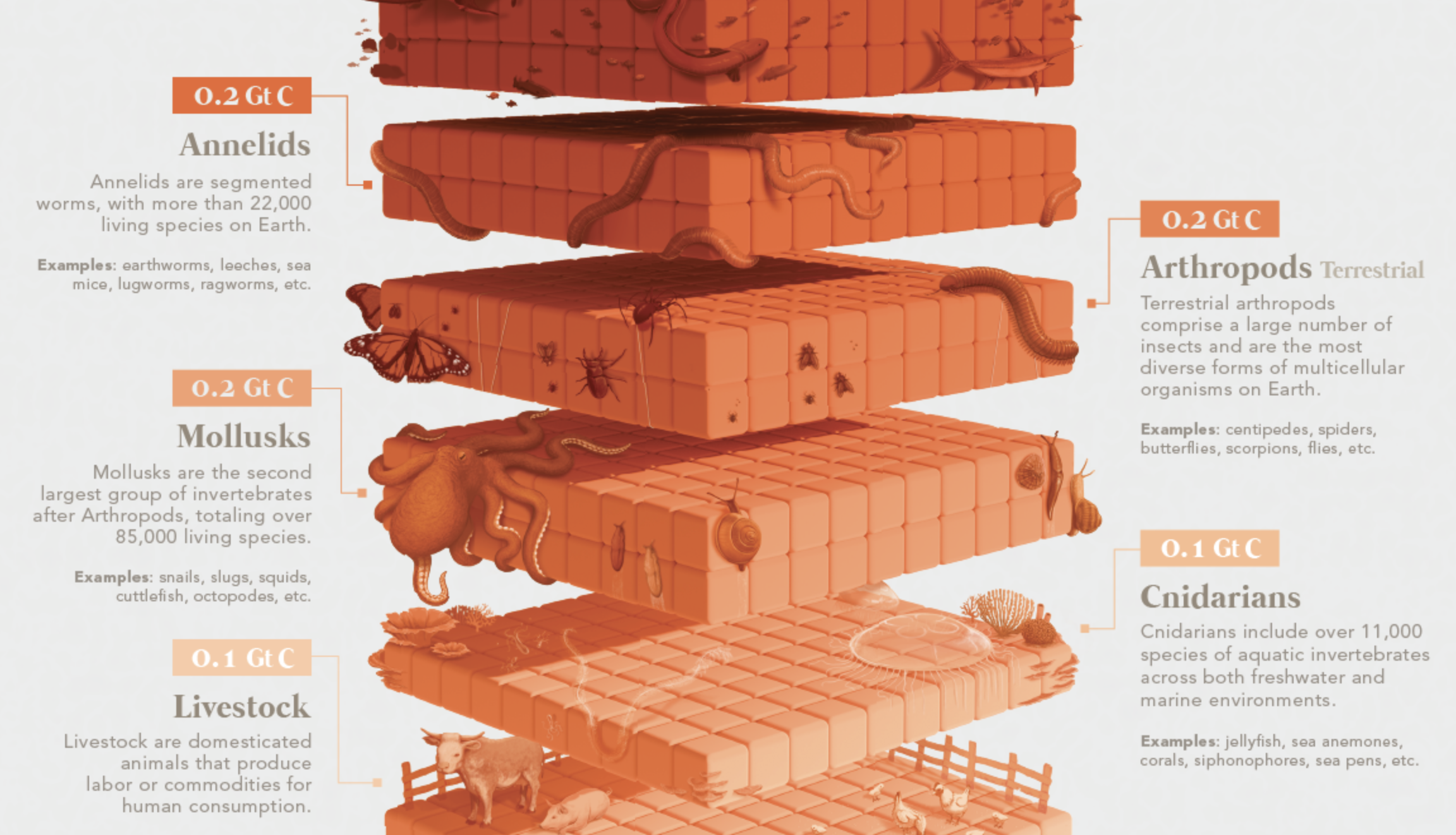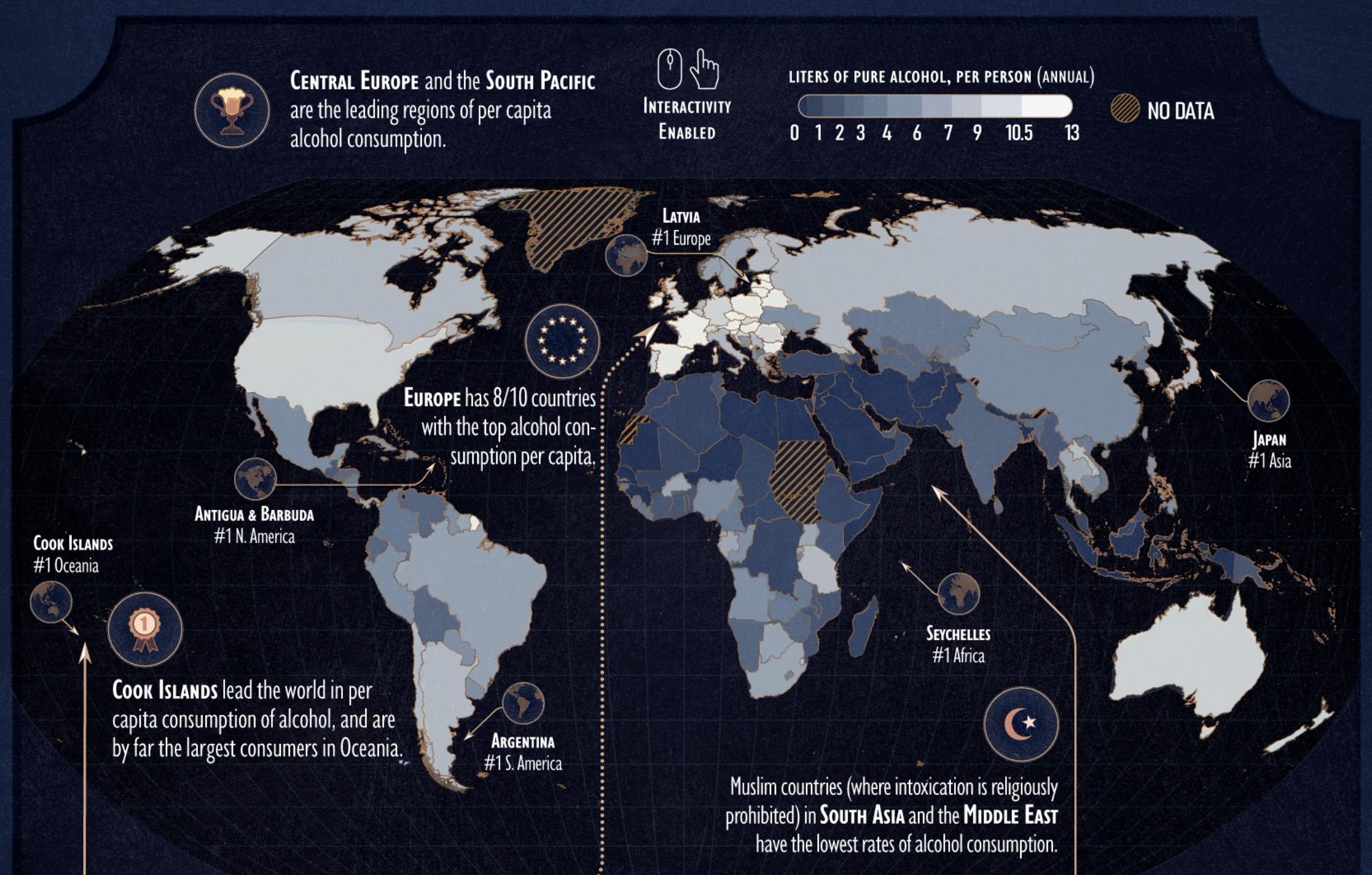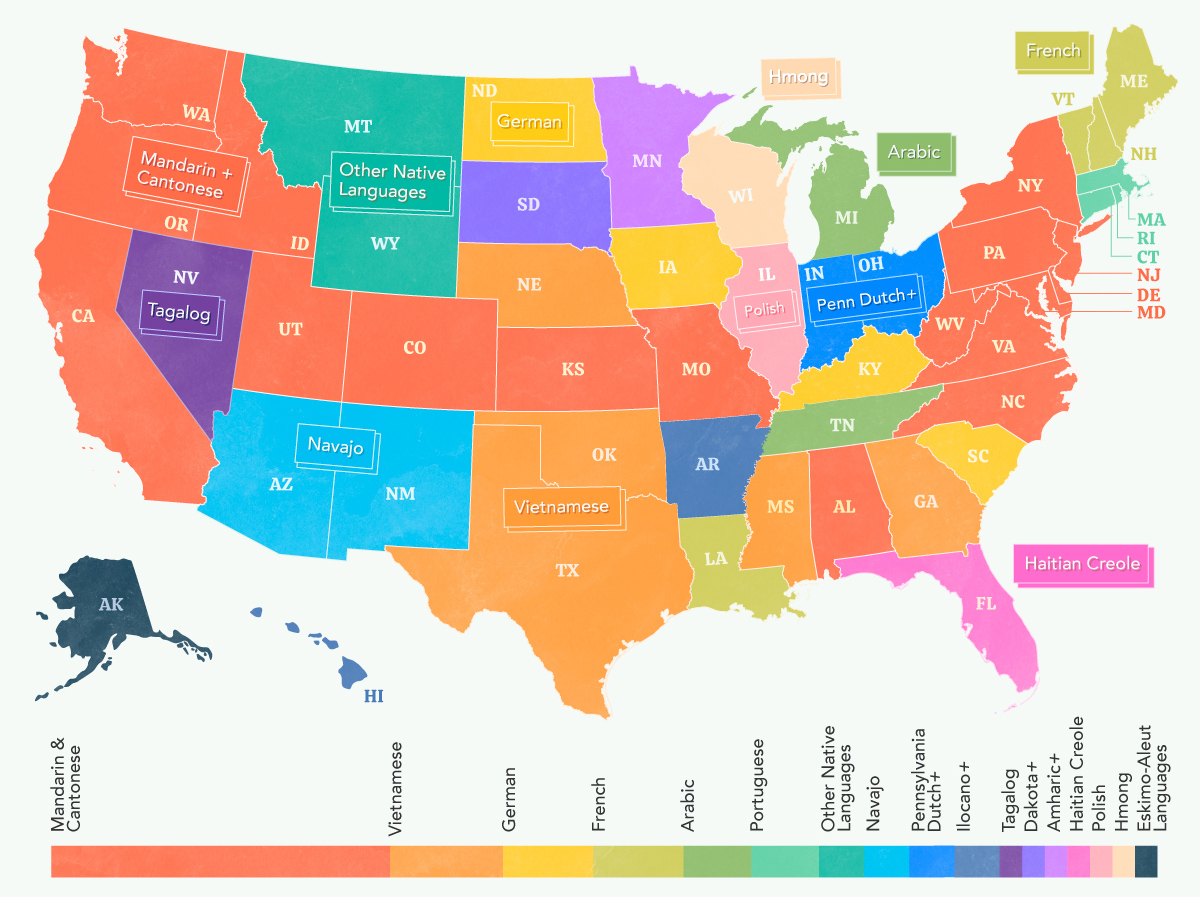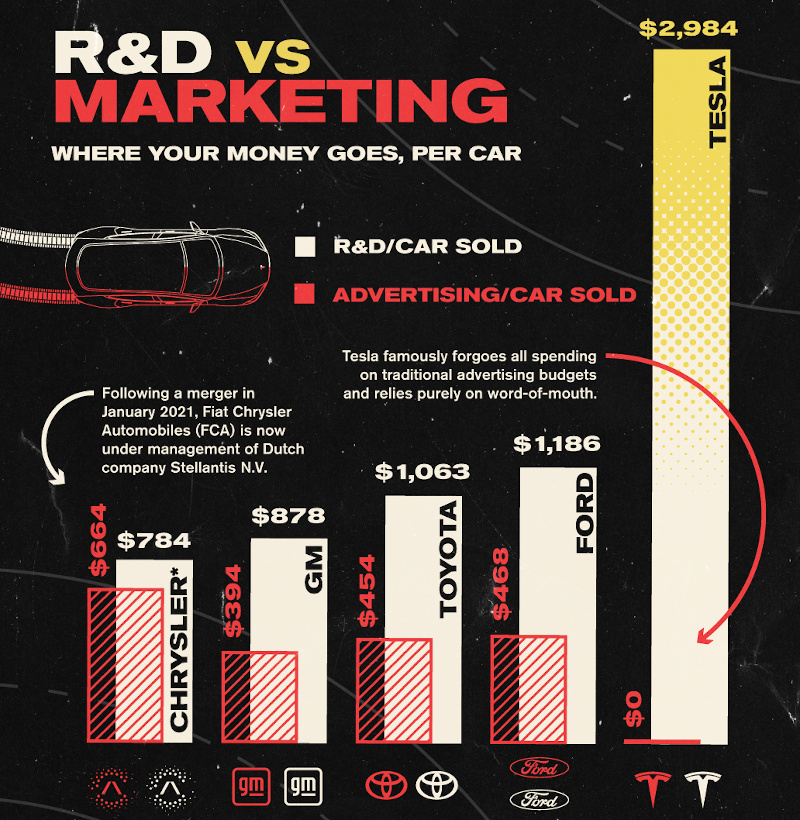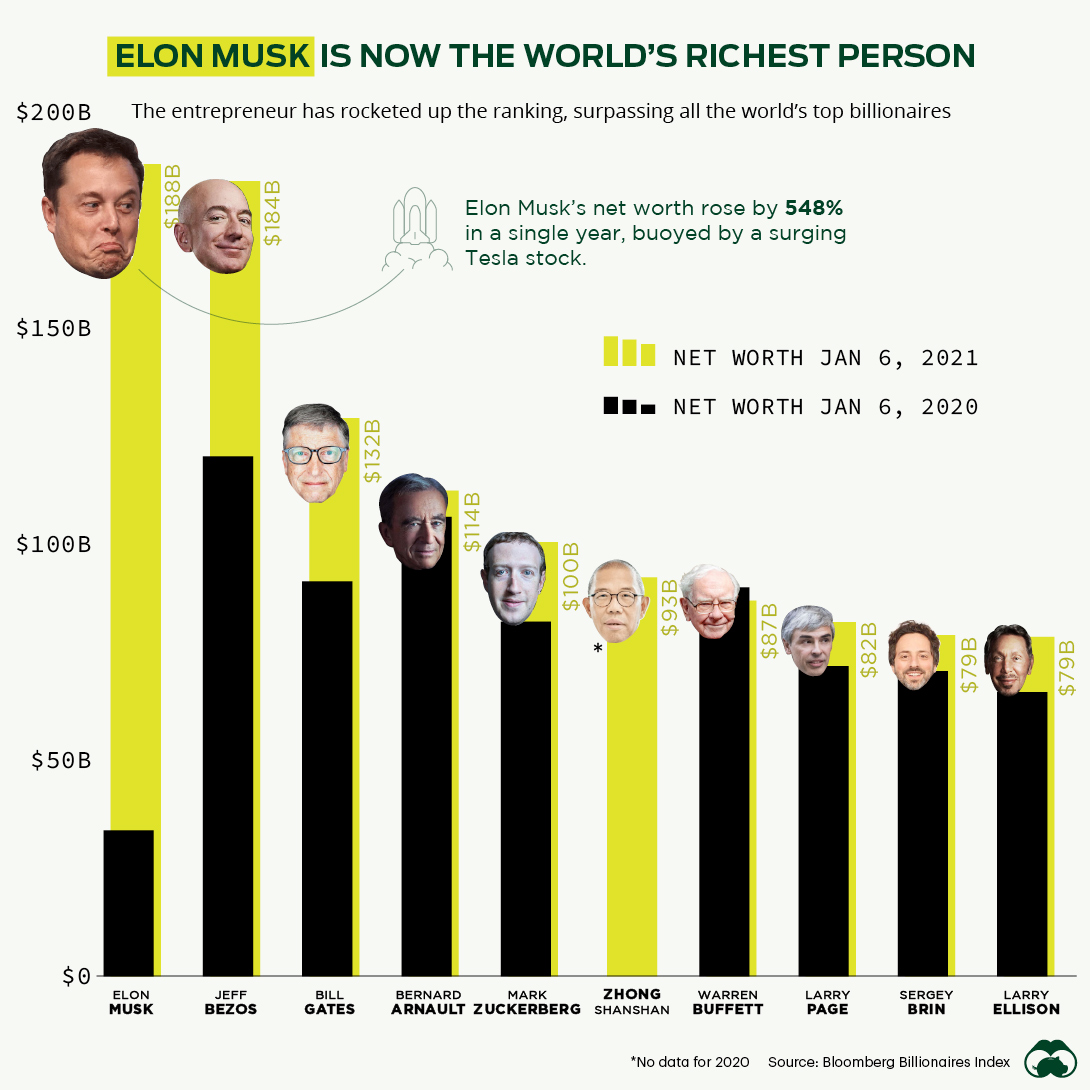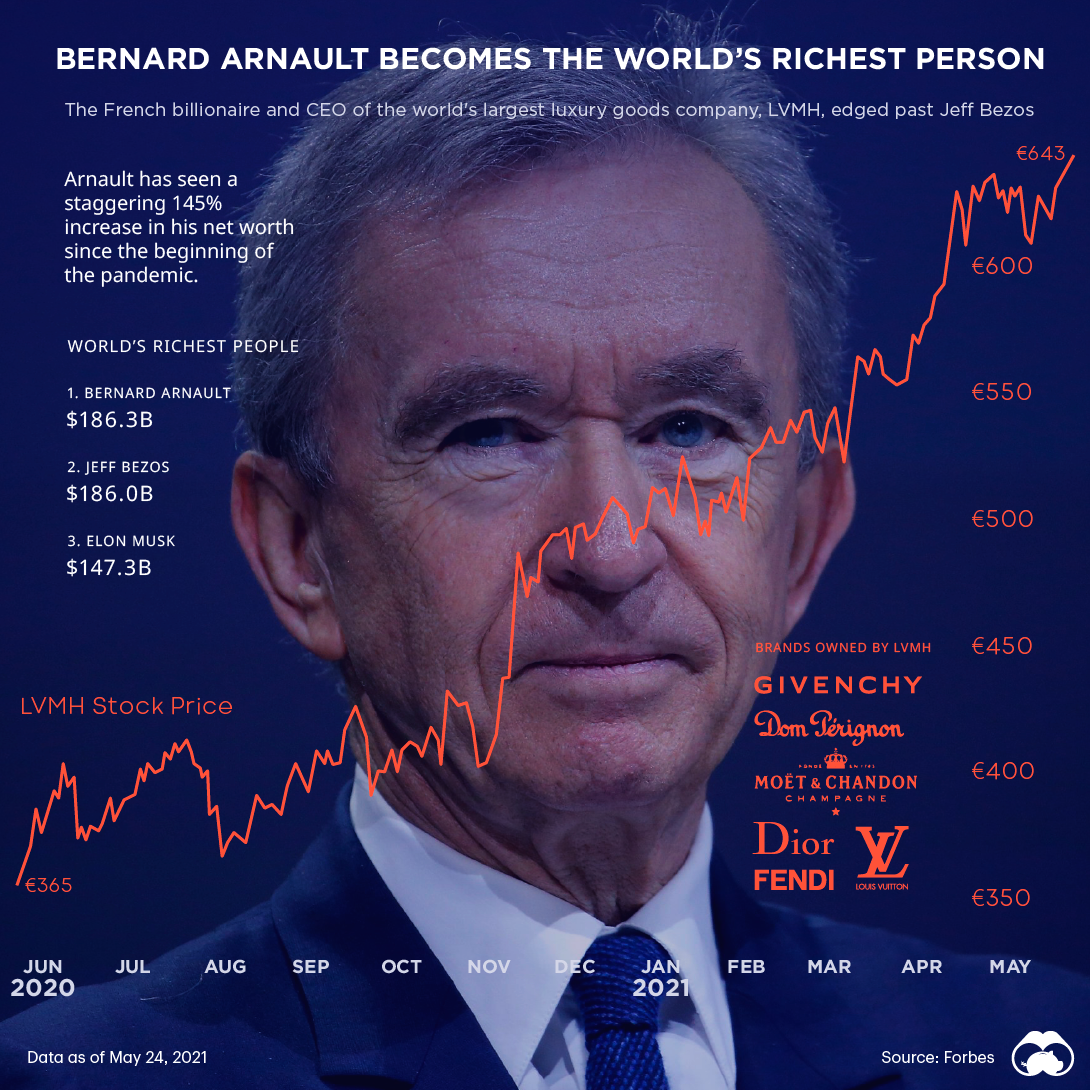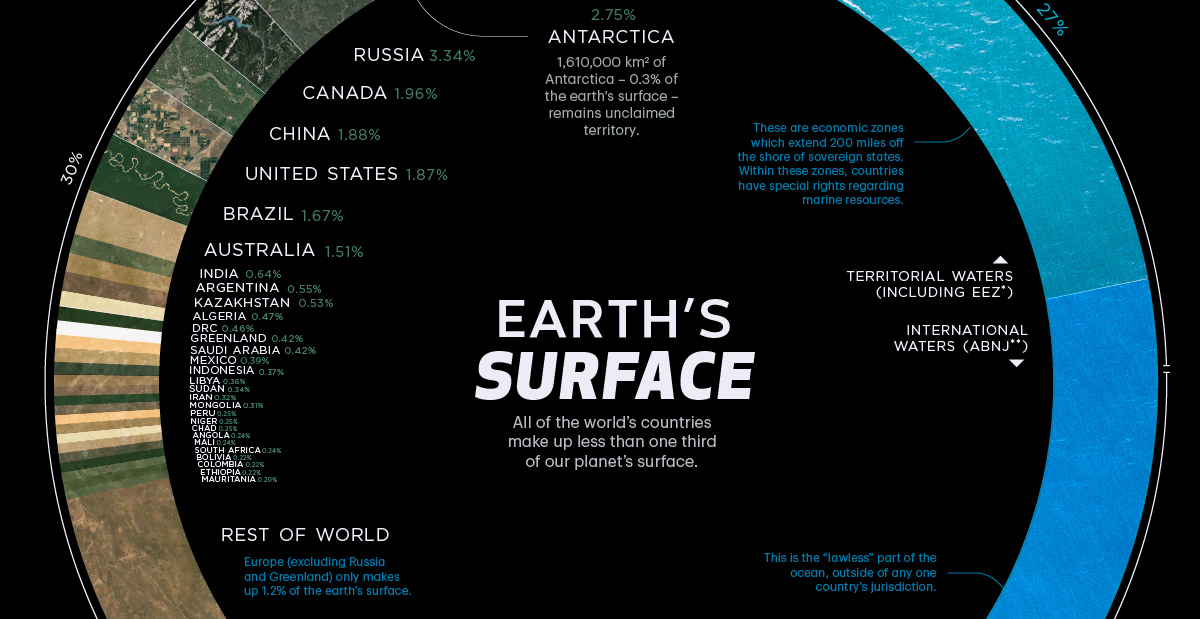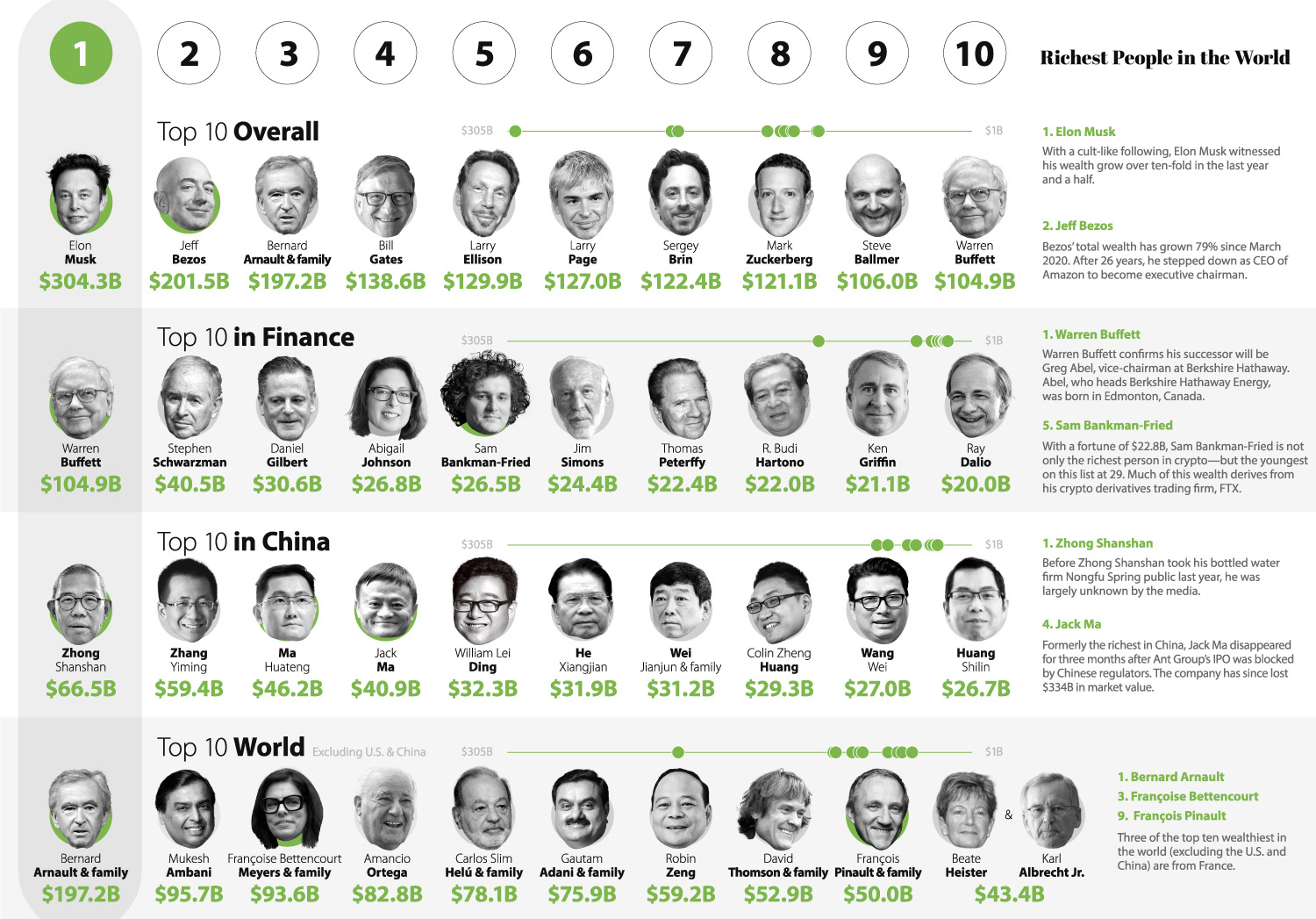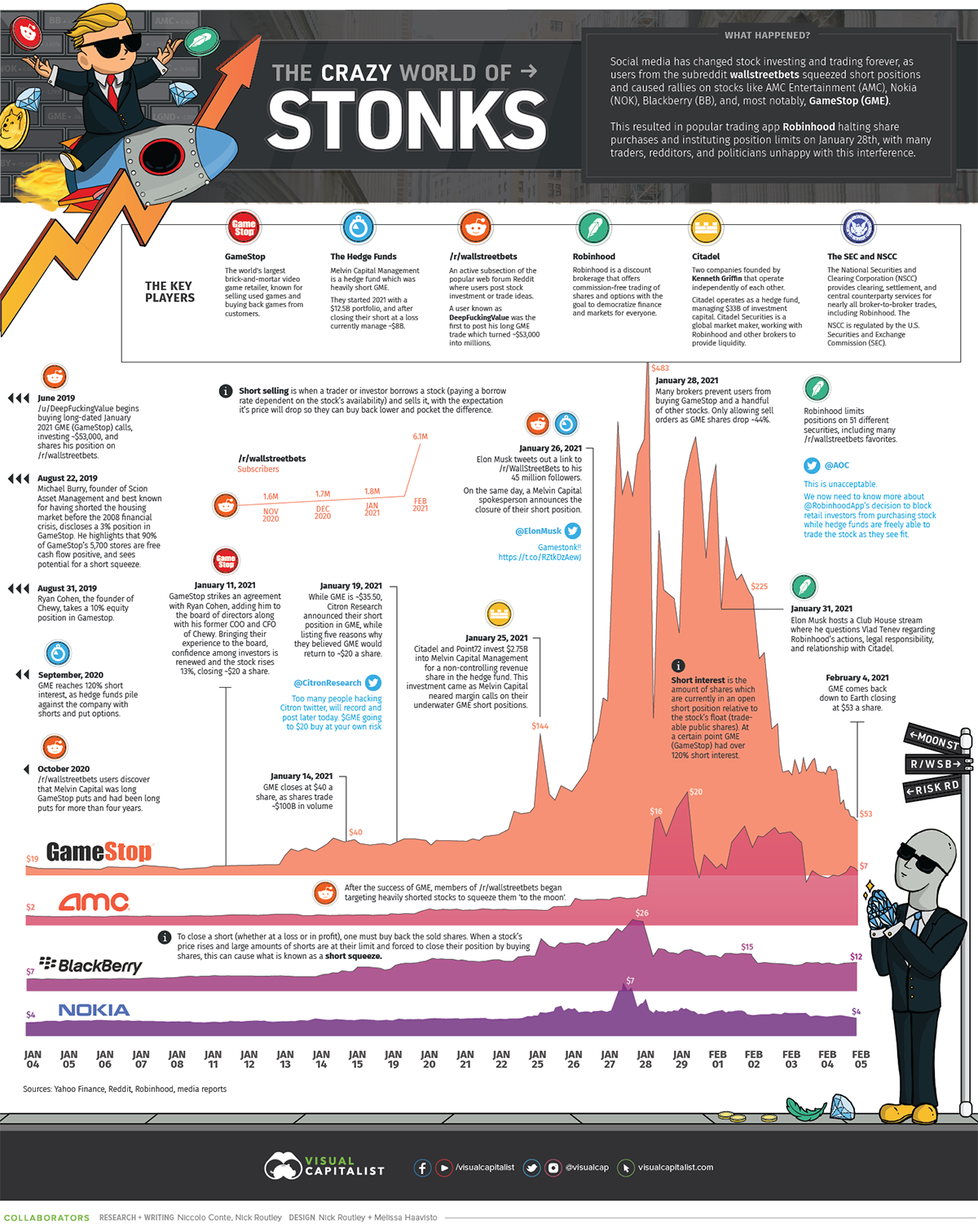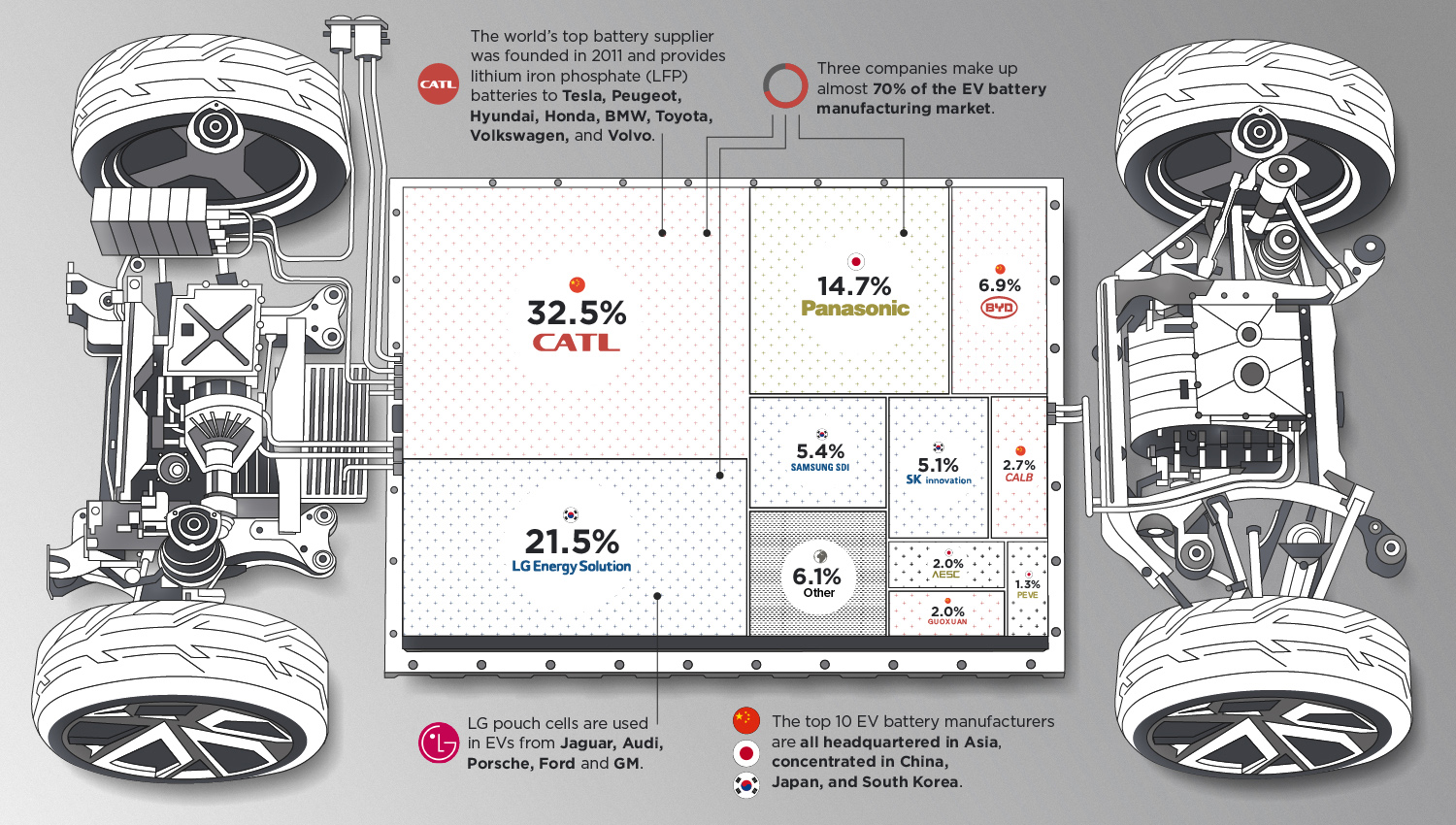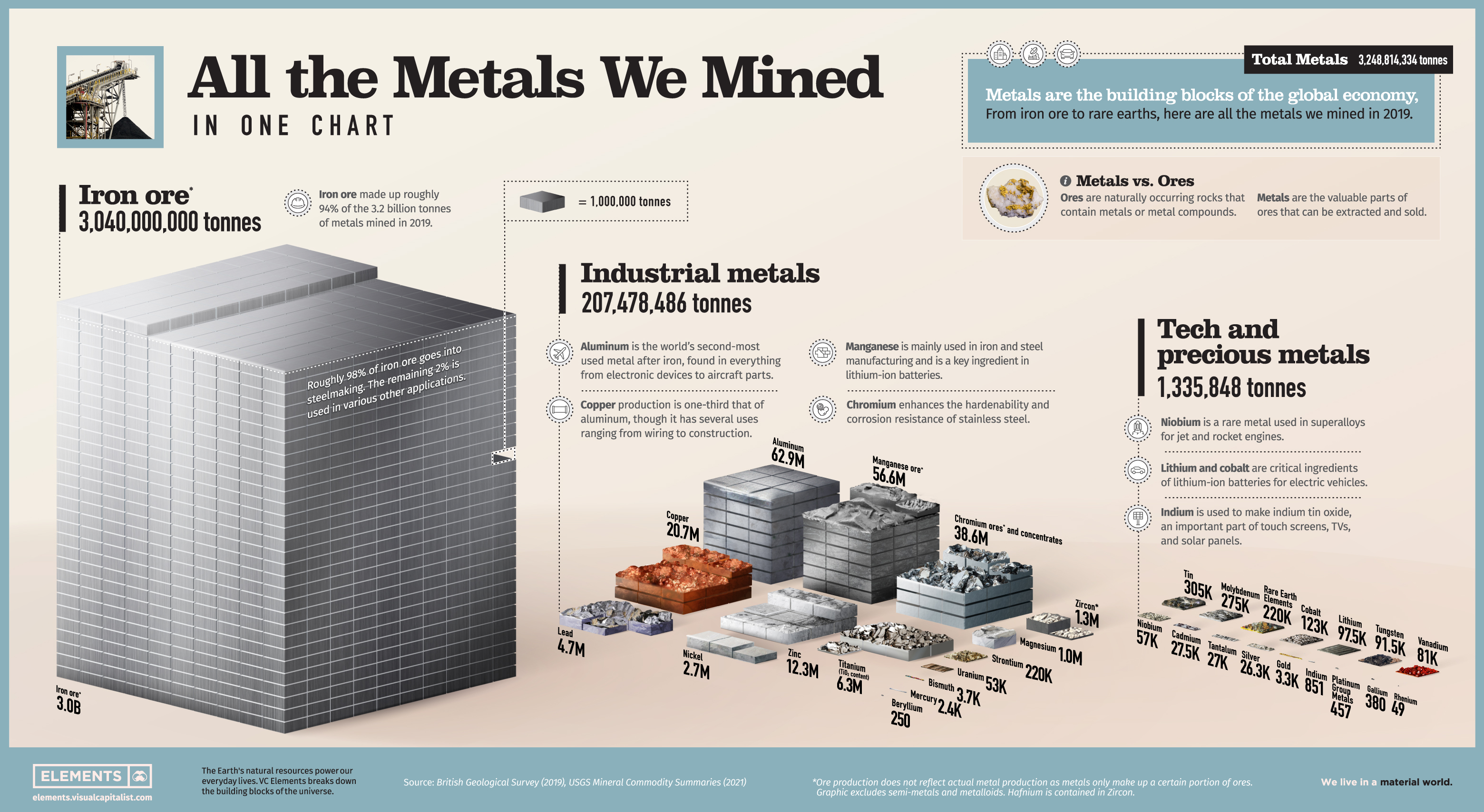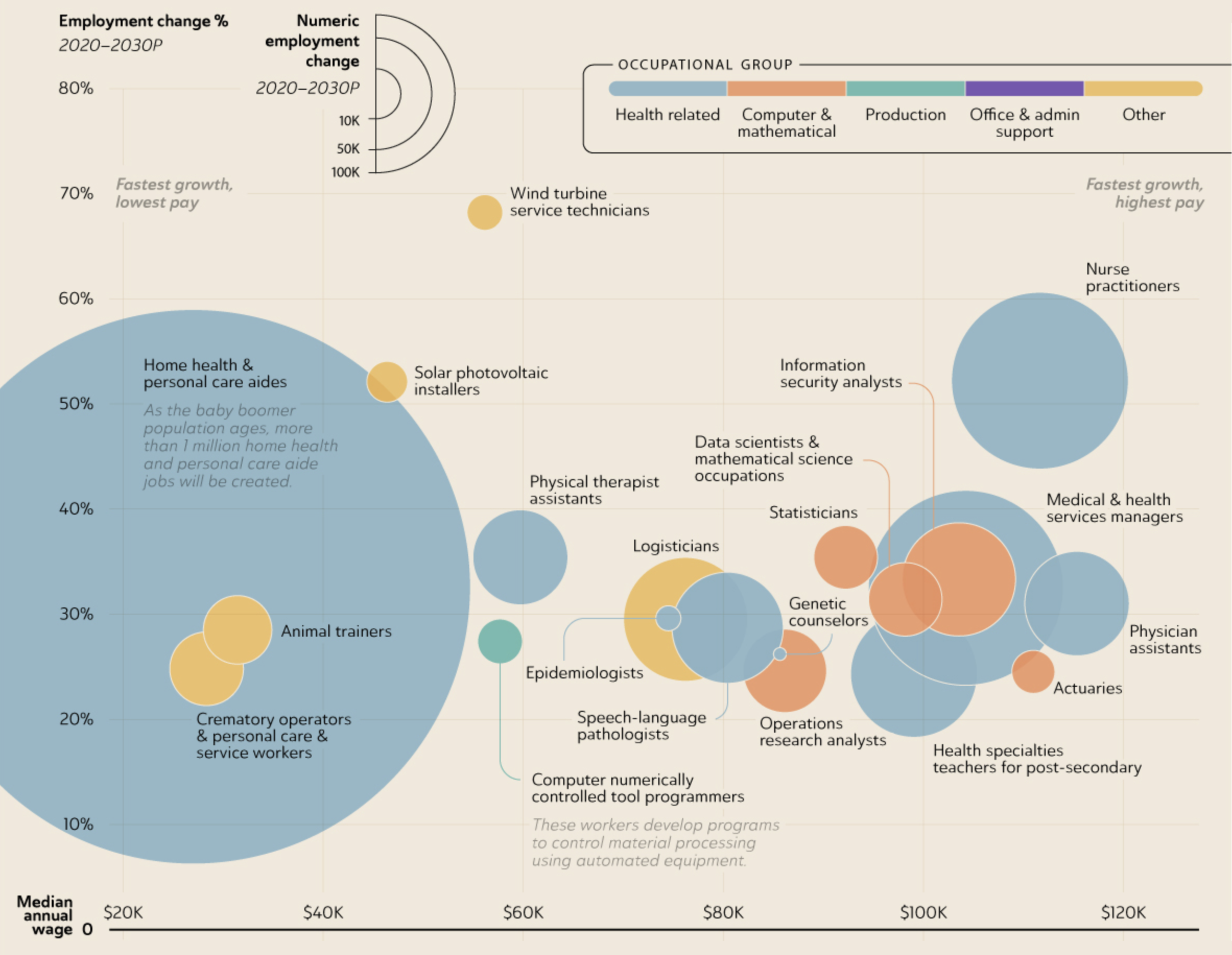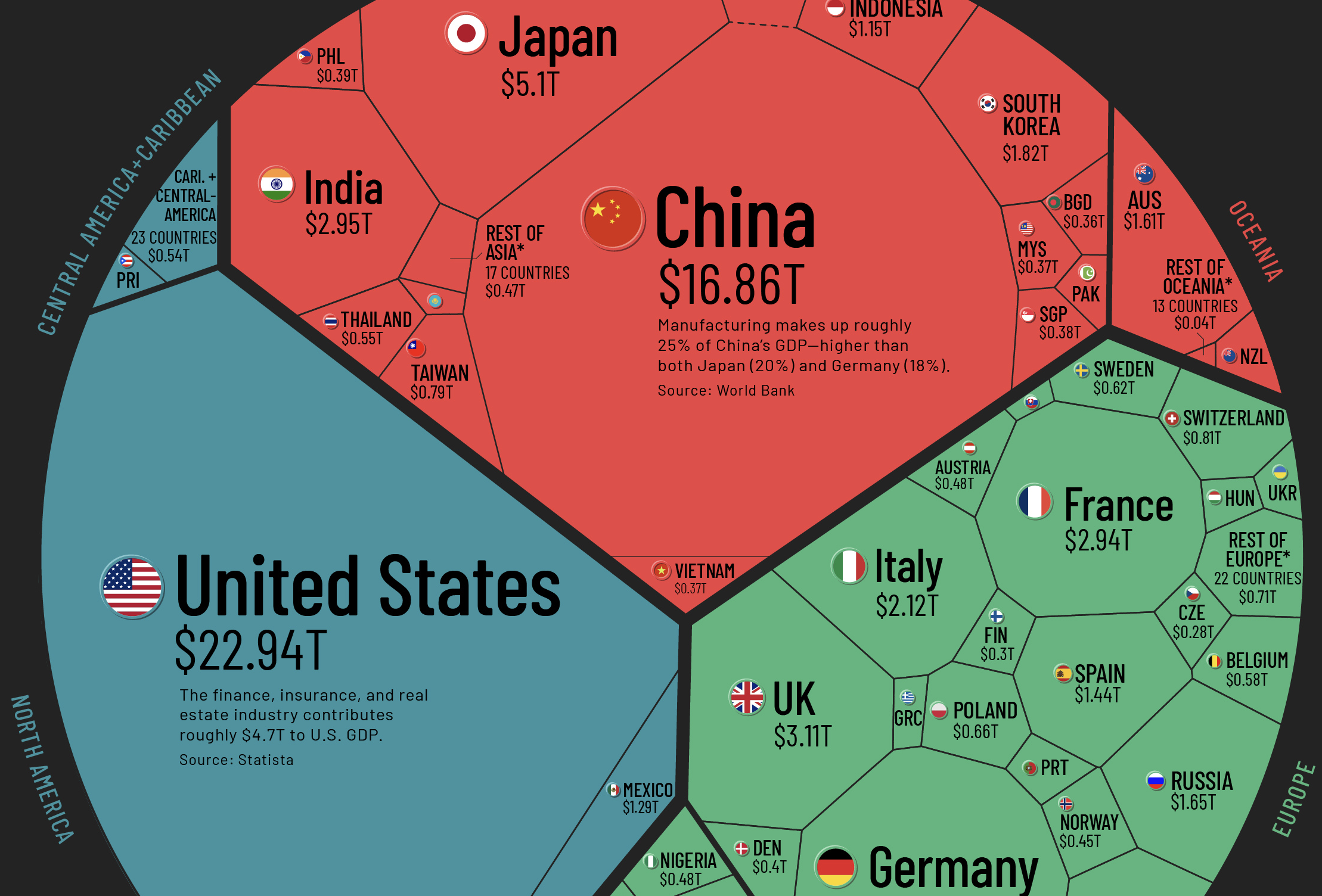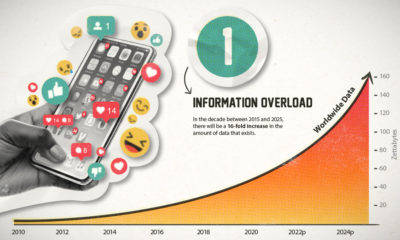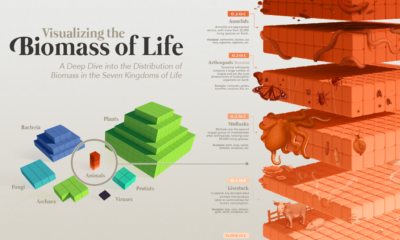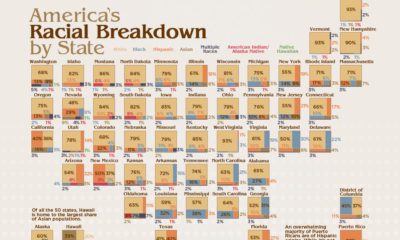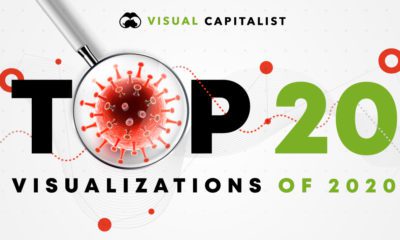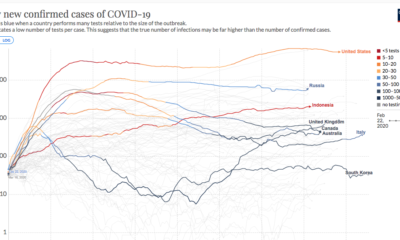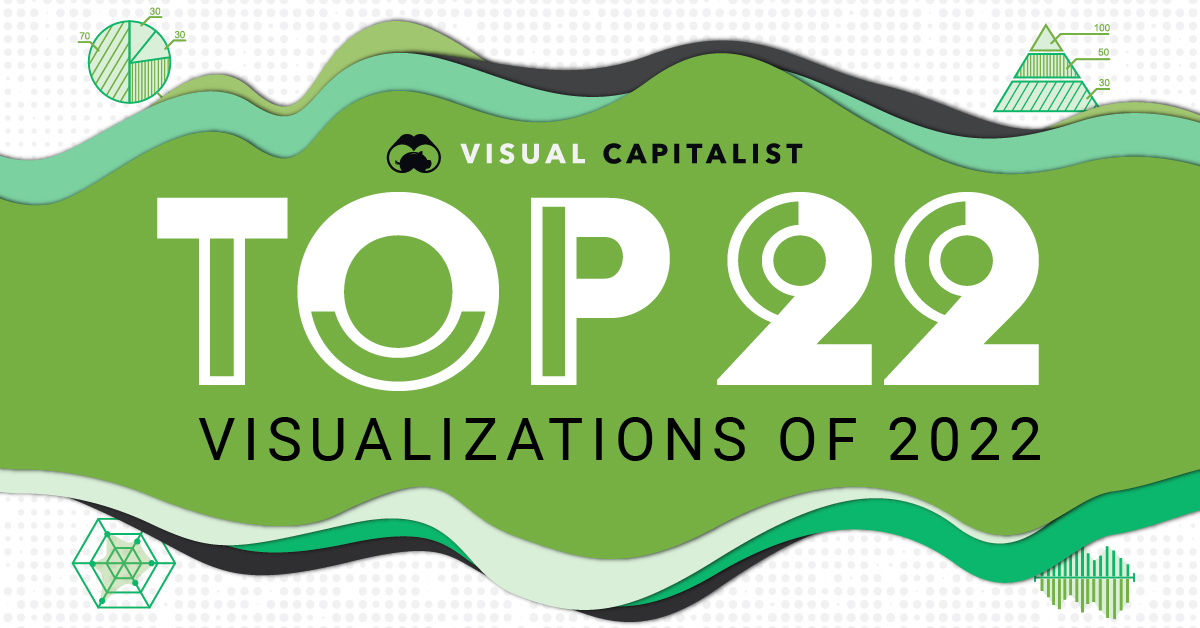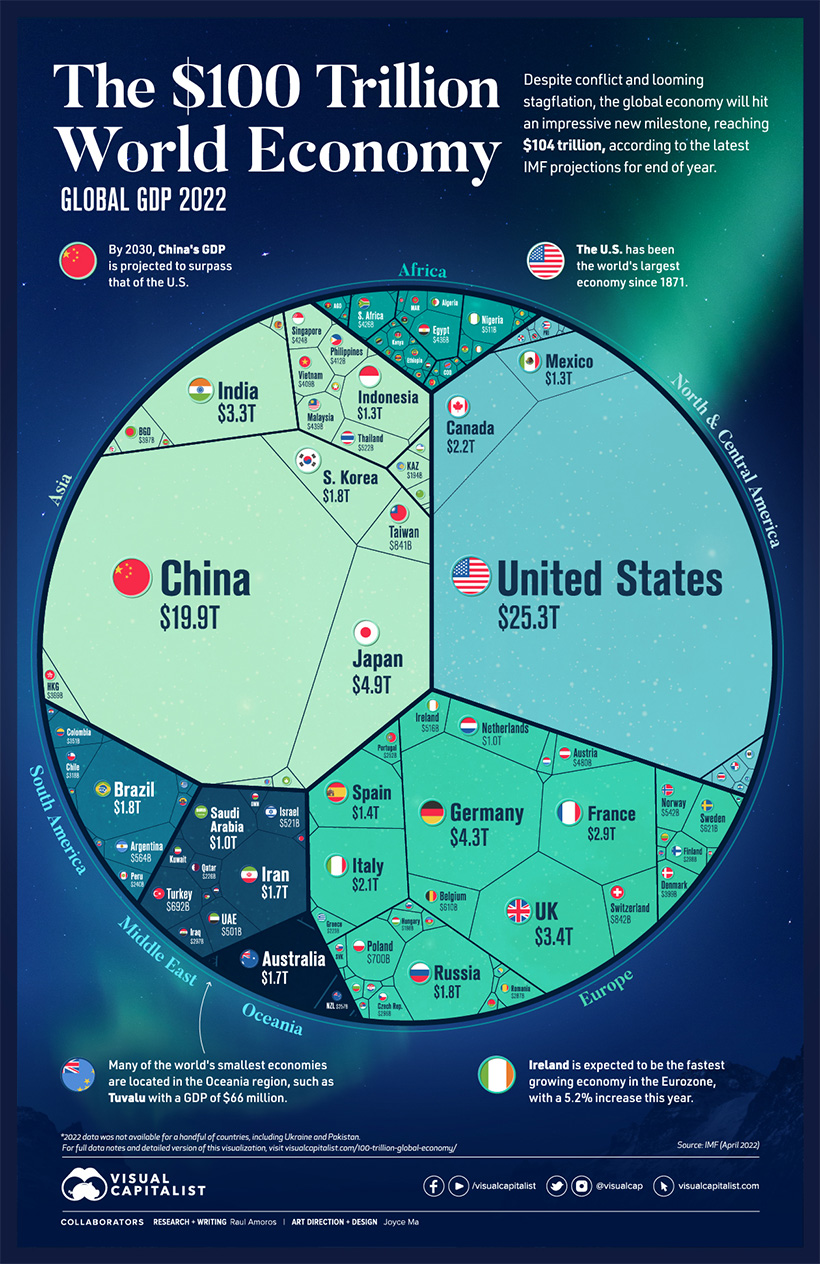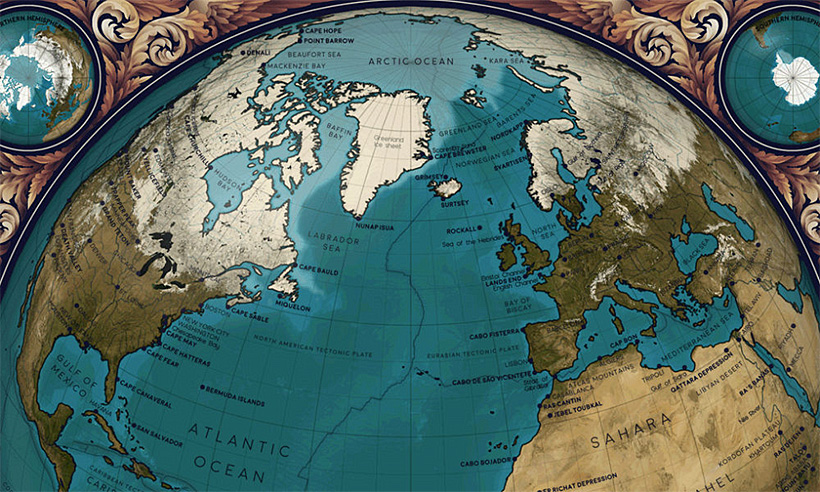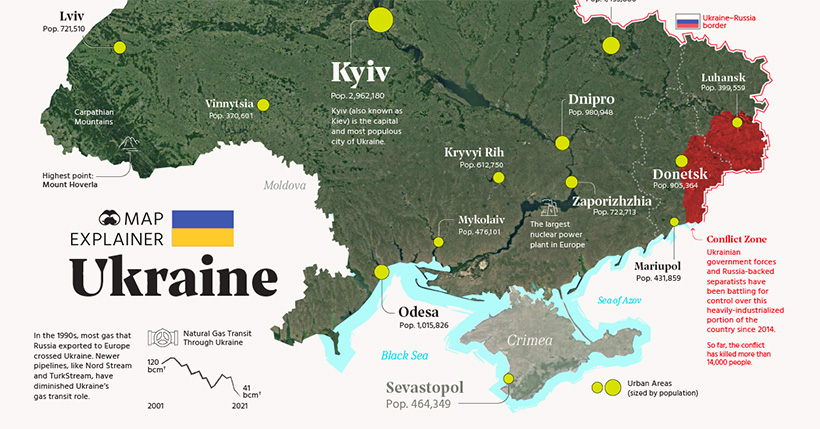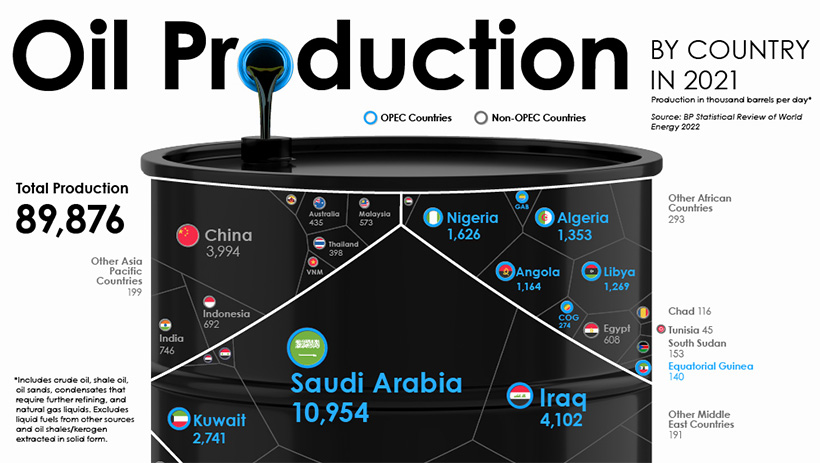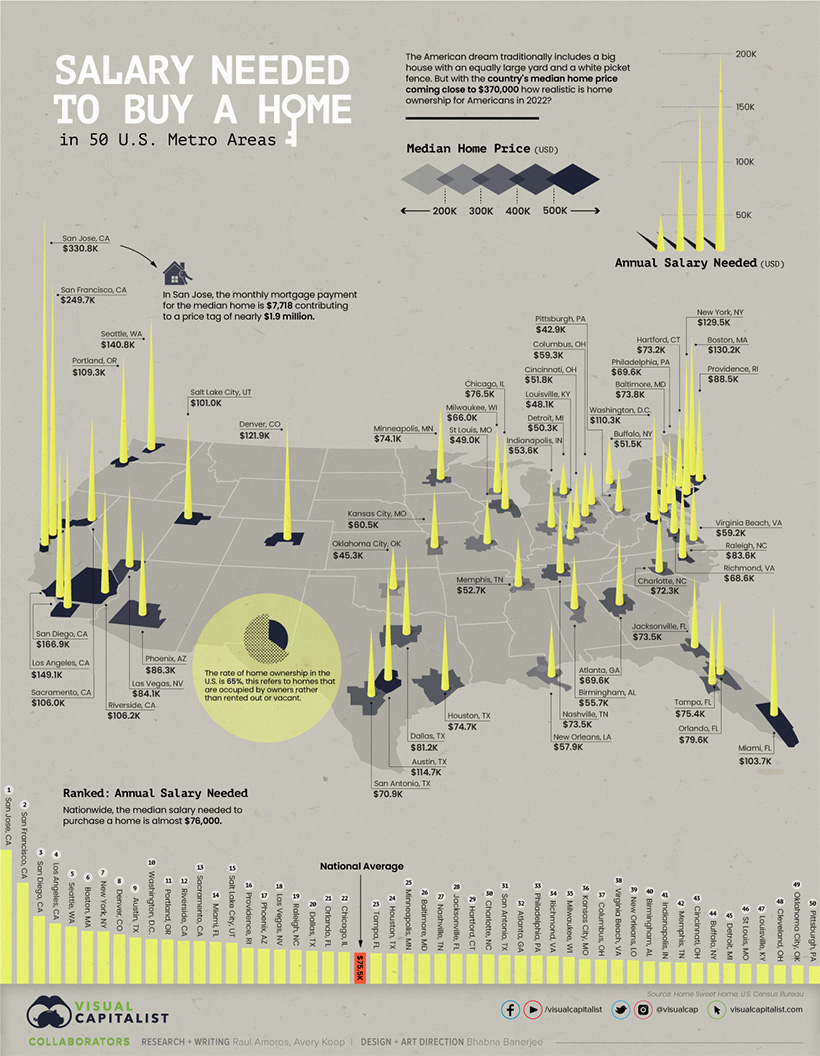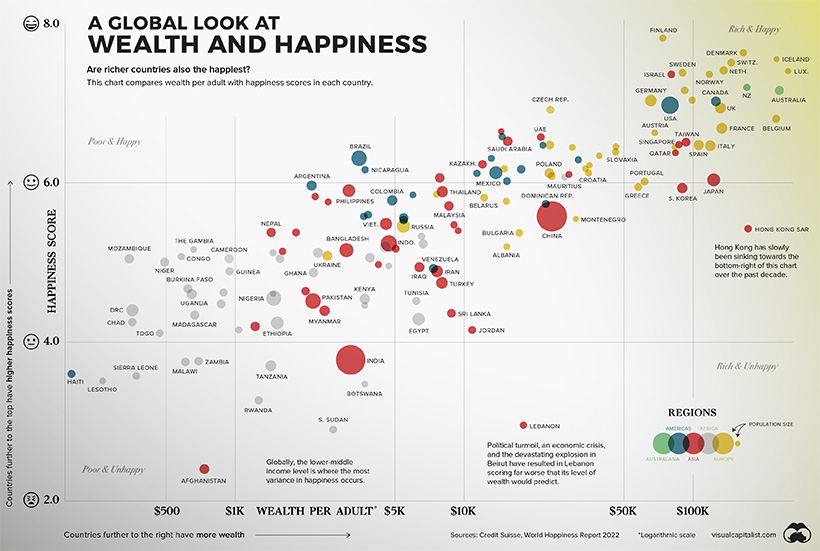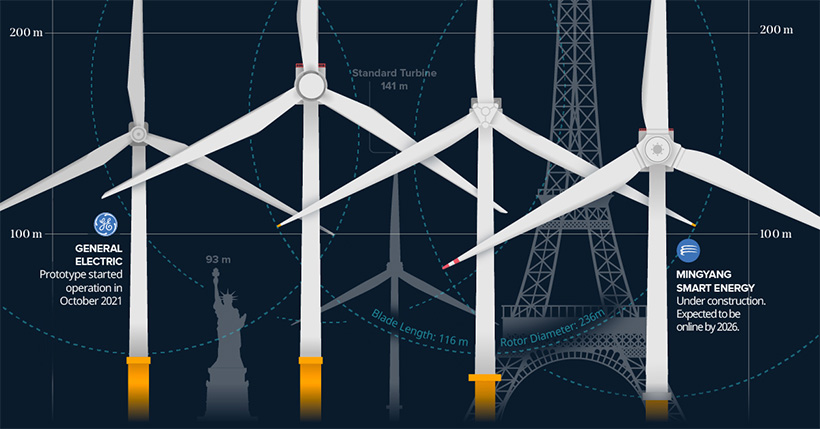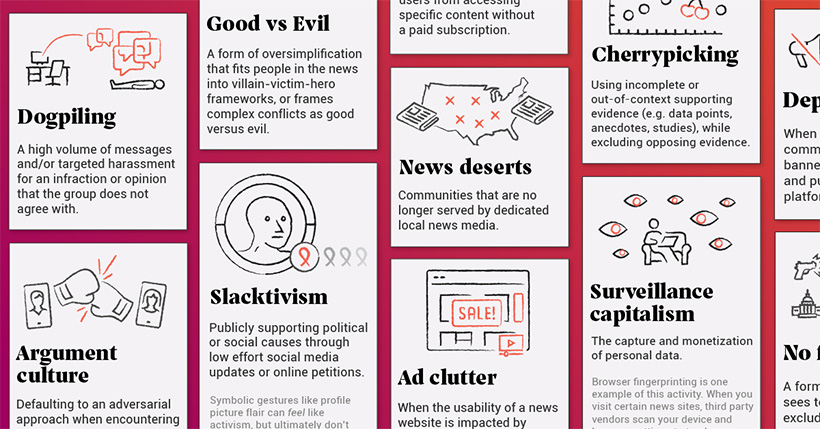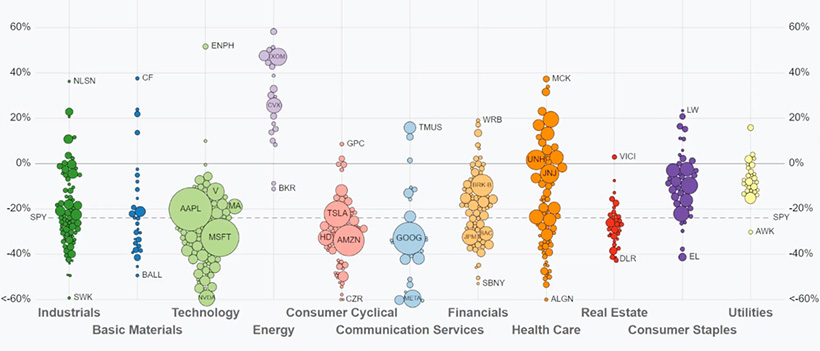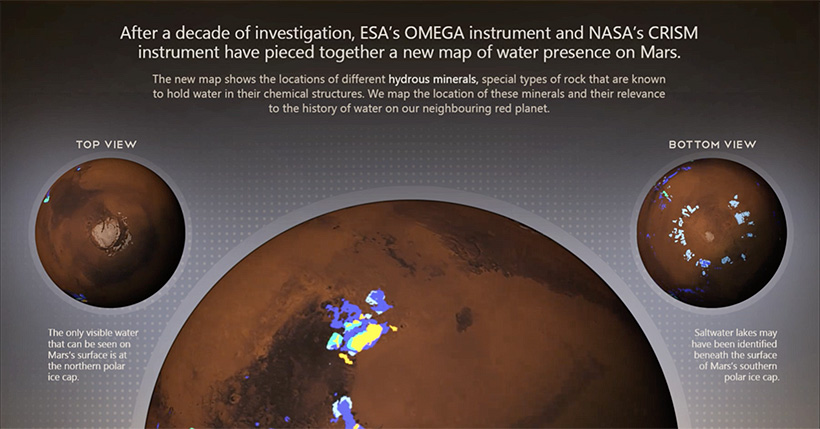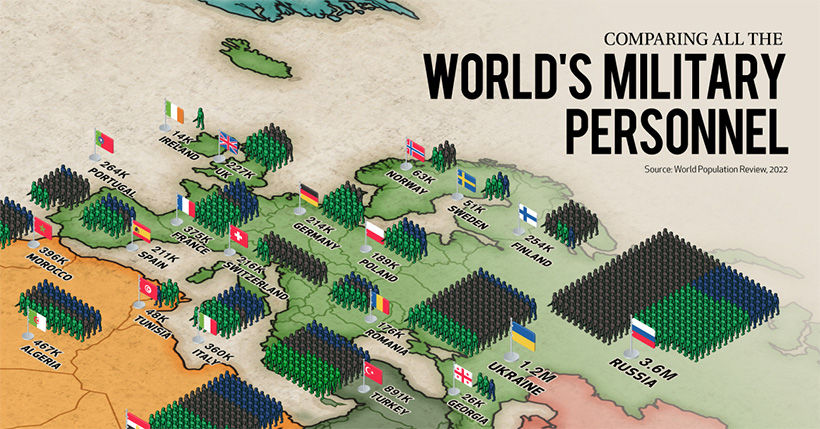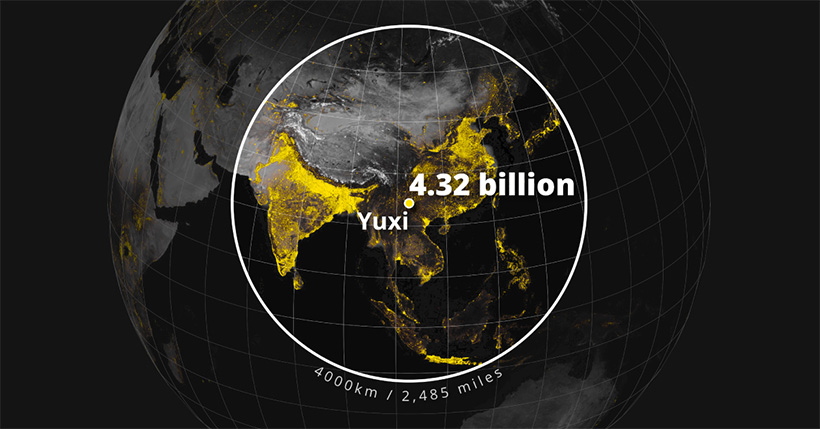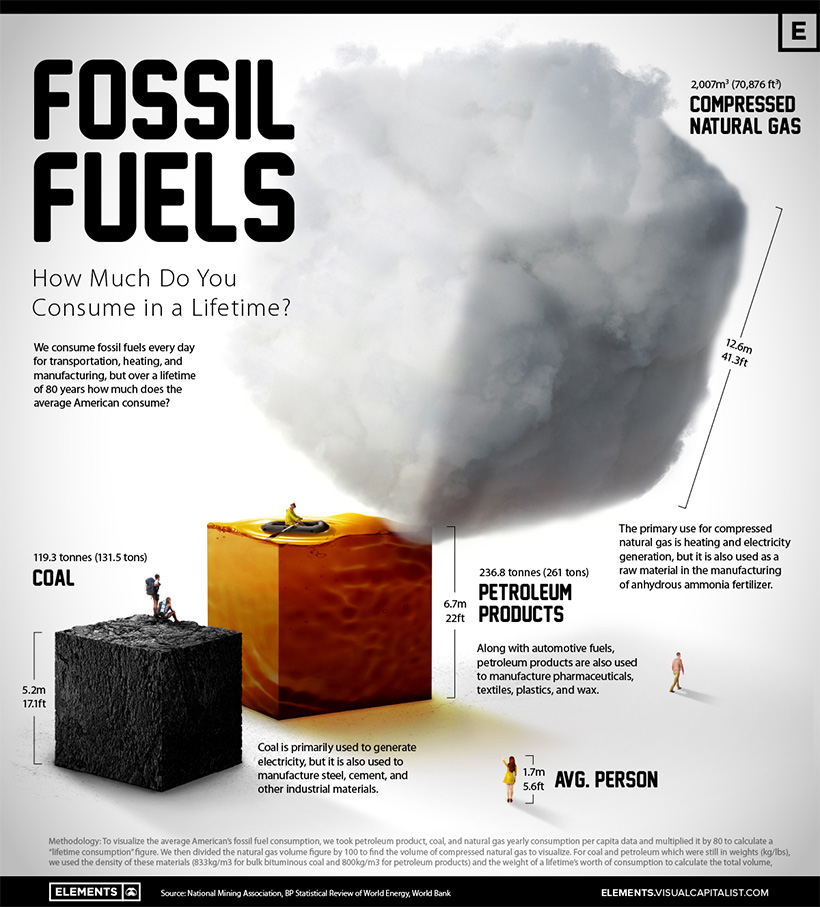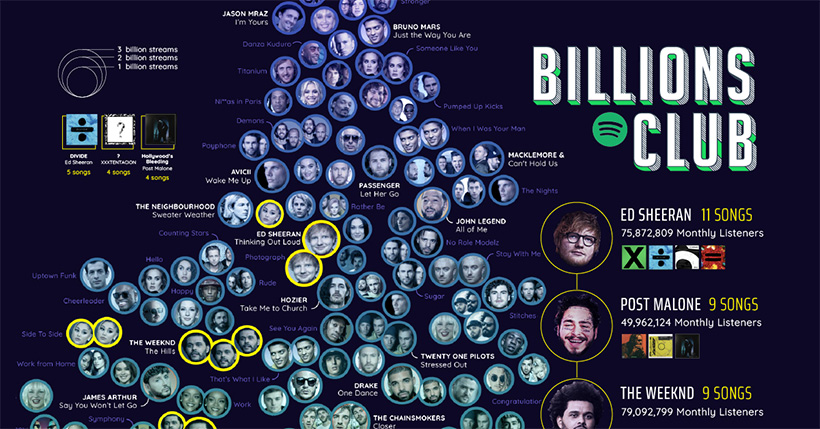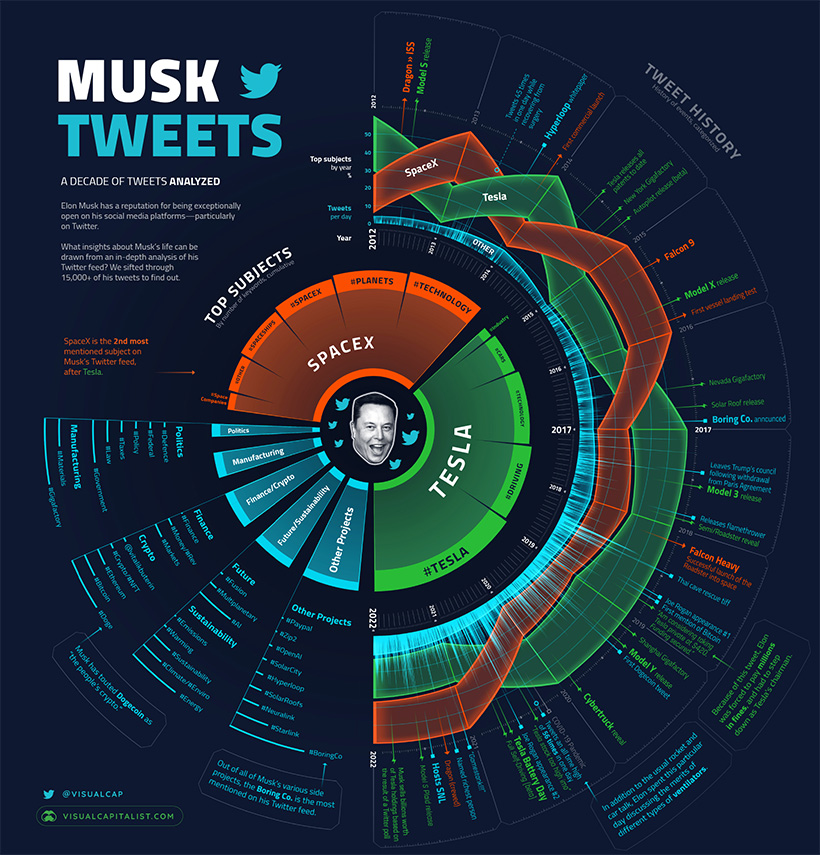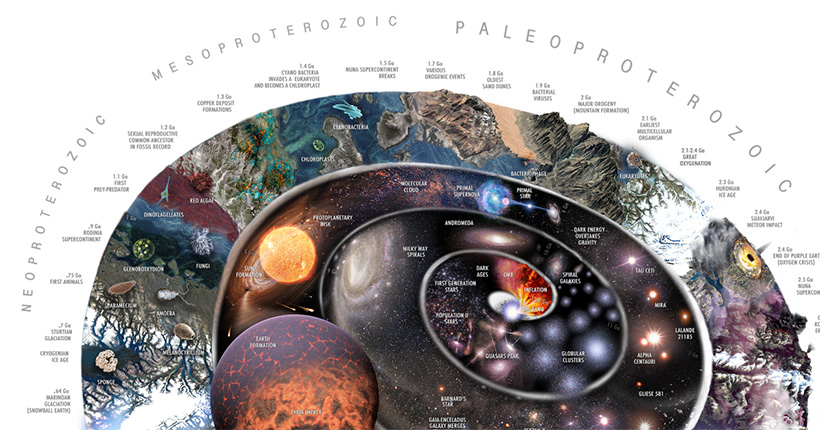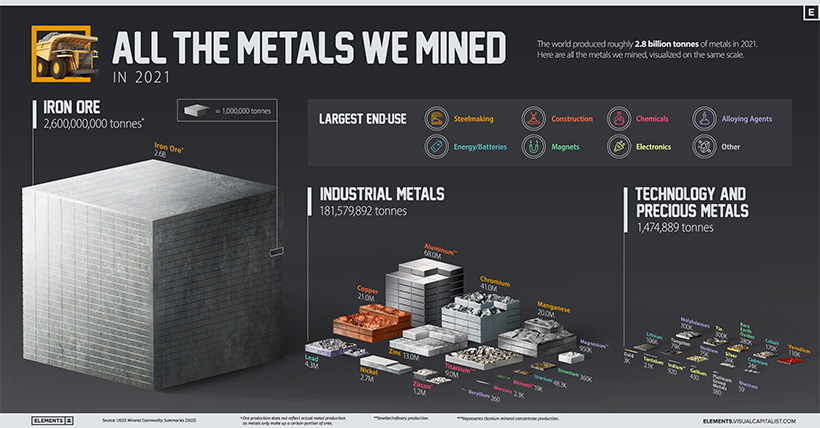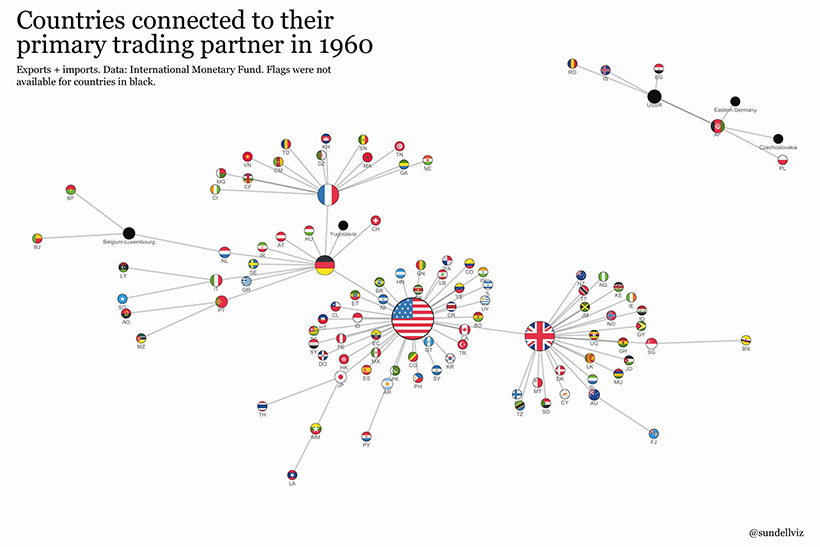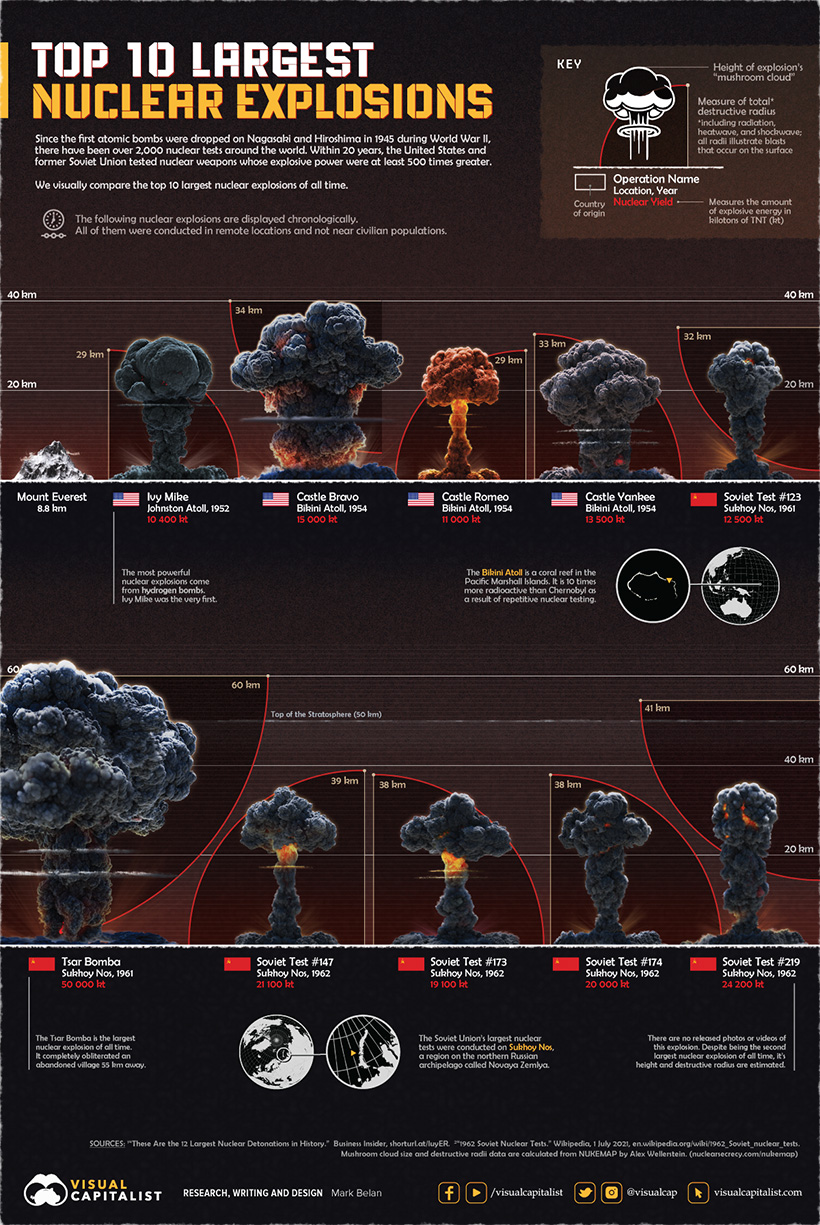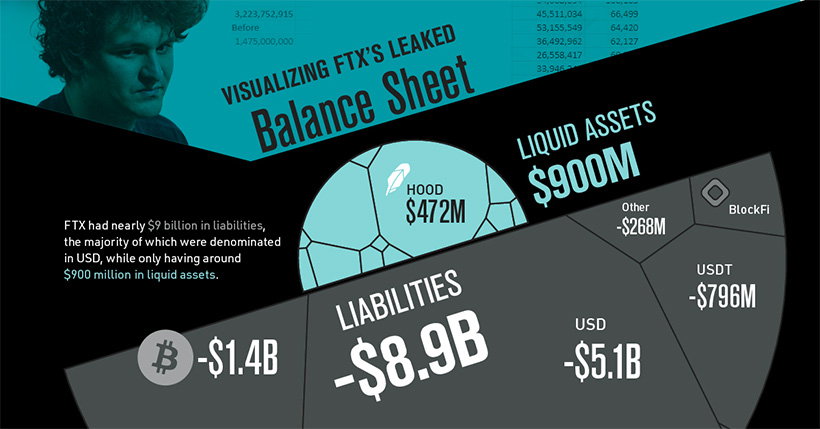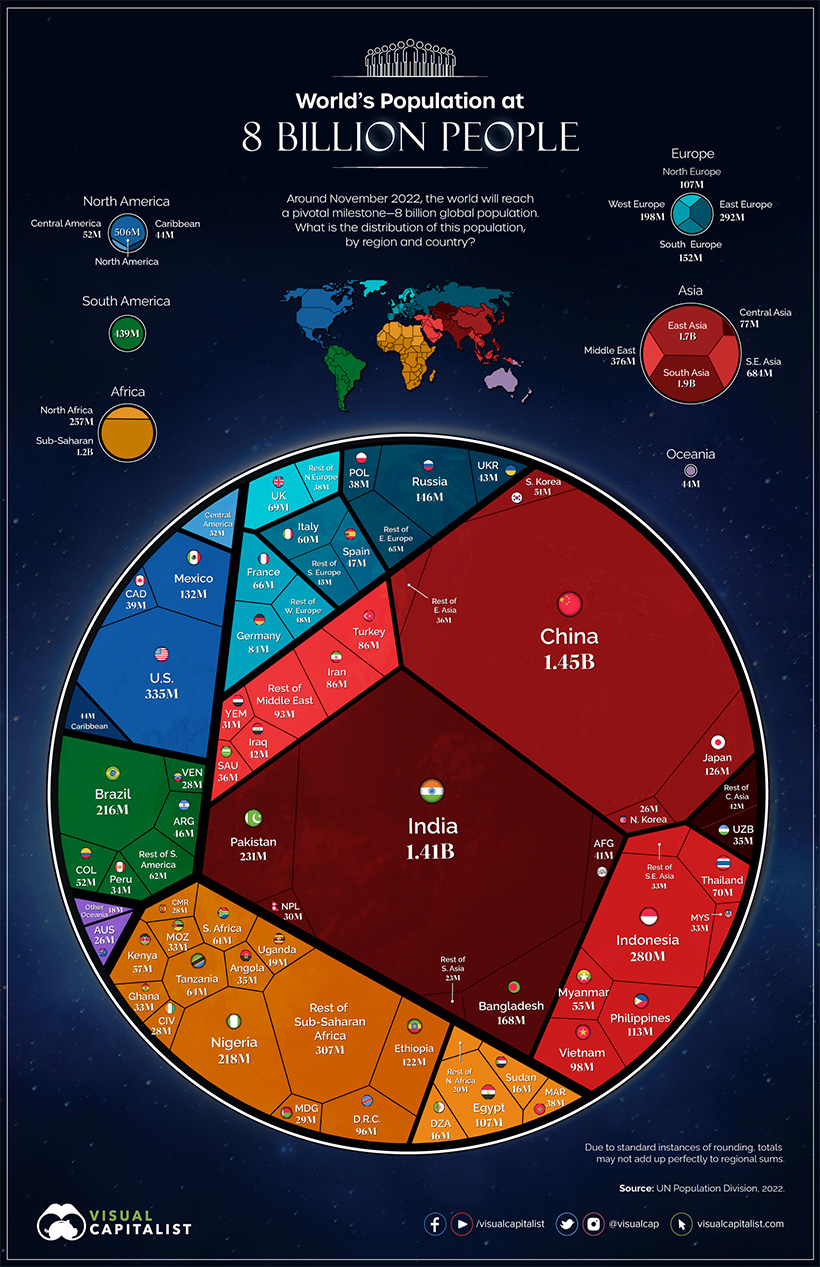In this eighth edition of our yearly round-up, we’ve curated a small selection of our most noteworthy work. Visualizations are highlighted because they reached a wide audience, sparked lively conversations, or broke new ground in design and data-driven reporting. Let’s dive in to our countdown of the top 21 visualizations of 2021. Editor’s note: Click on any preview below to see the full-sized version of a visualization.
The World Leaders In Positions of Power (1970-Today)
Who were the world leaders when the Berlin Wall fell? How many women have been heads of state in prominent governments? And who are the newest additions to the list of world leaders? The world’s superpowers have had a myriad of leaders over the years, but at the same time, it’s clear that some leaders have been able to stay in power longer than others. For example, since 1970, Japan has had 25 different heads of state, while the U.A.E has had only two in the same period.
Ranked: The World’s Fastest Growing Cities
Urbanization is one of the megatrends shaping the future of the global economy. With the world’s population expected to exceed 8 billion in the next 12 months or so, many cities, especially in Africa and Asia, are still growing rapidly. This visualization looks at the 20 fastest-growing cities worldwide based on population growth.
Visualized: Comparing the Titanic to a Modern Cruise Ship
It’s been over 100 years since the sinking of the Titanic, but its tragic story continues to live on. In this infographic, we compare the famous ship with Royal Caribbean’s Symphony of the Seas, which is currently the world’s largest cruise ship.
The 50 Richest Women in the World in 2021
From L’Oréal S.A’s Francoise Bettencourt Meyers and family (#1) to MacKenzie Scott (#3), we look at the fortunes of the wealthiest women, and where they are from. Using data from Forbes in early January, we found that 17 of the richest women were from America, followed by 12 from China, and three from France. As was the case with Bettencourt Meyers, many of the women on this list derived their wealth from a family business or inheritance. For example, the richest woman in China, Yang Huiyan (#5) controls a 57% stake in a real estate development company founded by her father. Alice Walton (#2) is part of the Walton family of Walmart fame—the richest family in the world, while Australia’s Gina Reinhart (#13) helped turn around her father’s fledgling iron ore company.
Razor Thin: A New Perspective on Earth’s Atmosphere
The Earth’s atmosphere extends 6,200 miles (10,000 km) past its surface, but less than one percent of that is habitable. Inspired by Andrew Winter, this visual compares the Earth’s atmosphere to the size of the state of Florida, illustrating how razor thin the “habitable zone” truly is. As one example, Mount Everest stretches past this habitable region all the way up to the “death zone”, which often requires humans to use bottled oxygen for survival.
Map Explainer: Key Facts About Afghanistan
As the situation in Afghanistan grew more tense in the summer of 2021, people were looking for ways to understand what was happening in that part of the world. While Afghanistan is oft-covered in headlines and news stories, the lion’s share of this coverage is directly related to the decades of conflict that have occurred in the region. In this map explainer, we step back and examine Afghanistan from a structural point of view, taking a closer look at the geographic and population patterns that define the country.
The 50 Most Visited Websites in the World
Over 2 trillion annual search queries drive Google’s web traffic. It comes as no surprise that the search engine is the most visited website worldwide, with 92.5 billion monthly visitors. But the big question is how does the rest of the internet compare? In this piece, we looked at how social networks, search engines, and news sites dominate the internet, and how the pandemic has shifted web traffic patterns—from Zoom to Twitch.
Timeline: 150 Years of U.S. National Debt
The U.S. has a lot of debt—$29 trillion as of Dec. 28, 2021. That’s well over 100% of annual GDP, a level not seen since World War II. The national debt quickly shrank after the war, but circumstances this time around are different. The COVID-19 pandemic is dragging on longer than most would have predicted, and the federal government is content with running massive deficits year over year. Get the full history of U.S. debt (as well as predictions to 2050) in this interactive timeline.
All the Biomass of Earth, in One Graphic
The human species’ contribution to the total weight of living things on Earth is approximately 0.01%. Within the animal kingdom, we are outweighed by other animal groups such as arthropods (insects), fishes, mollusks, and livestock, to name a few. Compared to the global biosphere, humans and the animal kingdom are greatly overshadowed by fungi and microbial organisms (bacteria, protists, and archaea). And by mass, plants are by far the most dominant lifeform on our planet.
Mapped: Countries by Alcohol Consumption Per Capita
Alcohol might be one of the oldest and most frequently used recreational substances in the world, but examining countries by alcohol consumption shows that usage is not equal. This unique interactive visualization breaks down per capita alcohol consumption into categories like beer, wine, or spirits, and then regenerates the map based on each country’s total.
Most Common Language in U.S. States (Excl. English or Spanish)
We typically operate under the assumption that Americans largely speak either English or Spanish. But the truth is, this culturally diverse country is home to a whole plethora of languages— more than you might expect. In this map, we explore the most common language apart from English and Spanish that is spoken in every U.S state. From Mandarin and Cantonese being popular languages spoken across the country to Indigenous languages making a steady comeback, you’ll learn something from this visualization.
Tesla’s R&D and Marketing Per Car vs. Other Automakers
Tesla was the world’s fastest growing brand in 2021, despite spending $0 on conventional advertising. On average, traditional automakers spend about $495 on advertising per vehicle sold. Tesla, on the other hand, invests heavily in research and development, allowing for innovation and the development of cutting-edge technologies. This chart compares Tesla’s spending on marketing and R&D compares to giant automakers like Ford, Toyota, and General Motors.
World’s Richest Person: Elon Musk & Bernard Arnault
Since 2017, Jeff Bezos has been a fixture at the top of the global wealth leaderboard, but the first week of January in 2021 marked a change. For the first time ever, Elon Musk took the top spot on the billionaire list after seeing Tesla’s stock skyrocket 1,030% since the beginning of the pandemic. However, this lead would not hold for long…
In May 2021, French billionaire Bernard Arnault briefly became the world’s richest person with a net worth surpassing $186 billion. At this point in time, Arnault’s fortune (largely tied to luxury conglomerate LVMH) had seen a staggering 145% increase since the beginning of the pandemic. A seemingly more permanent shift would happen later in the year: as of time of publishing, Elon Musk is the world’s richest person with a commanding lead of almost $80 billion over Jeff Bezos.
Visualizing Countries by Share of Earth’s Surface
We’re used to seeing Earth in map form, but the continents and oceans as they’re currently arranged make it difficult to gauge how much land and ocean there actually is on the planet’s surface. Further complicating matters is the fact that distortions in common maps can skew our perceptions of how big certain countries are in relation to one another. This visualization simplifies the world into a donut chart, so we can see the components of the Earth’s surface in a more manageable format.
The Richest People in the World in 2021
Who is the richest person in 2021? That’s a tough question, because this year was a dynamic one at the top of the leaderboard of the world’s wealthiest. As noted above, Elon Musk, Bernard Arnault, and Jeff Bezos have all held the top spot at various points in time. The above graphic, updated in November 2021, gives the most recent data on the topic. This includes highlighting newcomer Sam Bankman-Fried, founder of crypto derivatives trading company FTX, who is now the richest person in crypto, and one of the youngest billionaires globally at 29 years old.
The Crazy World of Stonks Explained
At the end of January this year, electronic retail company Gamestop went on a wild roller coaster ride, seeing its share price rise by roughly 640% in just a few days. The story involves frenzied posts on the Reddit community r/wallstreetbets, stock prices rising “to the moon”, an epic short squeeze, hedge funds almost going bust, stock halts, and much more. We highlight the crazy world of stonks in this graphic, showing that the rise of information sharing related to stock trading over the past year has undoubtedly changed how financial markets will be traded forever.
Ranked: The Top 10 EV Battery Manufacturers
“In an electric future, batteries are as essential to transport as oil is today,” tweeted Tesla founder Elon Musk when he saw this graphic about the top 10 EV battery manufacturers. With an increasing interest in electric cars, the battery market is now a $27 billion per year business that could grow to $127 billion by 2027 as the world moves away from fossil fuels. This graphic breaks down the growing industry, totally dominated by Asian companies.
All the Metals We Mined in One Visualization
The world’s material appetite is growing with its population, and metals are an important part of it. While some metals are essential for infrastructure, others help power our phones and computers. This chart shows the 3 billion tonnes of metals mined annually on a relative scale.
The 20 Fastest Growing Jobs in the Next Decade
The employment landscape is constantly shifting. Some industries spring up seemingly out of nowhere, and new roles are created to help fuel the disruption. On the flip side, relentless automation and economic factors can result in widespread job cuts as factories close and roles are rendered obsolete. This visualization looks at the fastest growing jobs from 2020 to 2030, as predicted by the U.S. Bureau of Labor Statistics.
Visualizing the $94 Trillion World Economy in One Chart
What did the global economy look like in year two of the pandemic? With a nominal GDP of $22.9 trillion, the U.S. made up roughly a quarter of global output based on estimates from the IMF. Following the U.S. is China, at $16.9 trillion and Japan at $5.4 trillion. This Voronoi-style visualization, which has received millions of views on Visual Capitalist in the last couple of weeks, breaks down the global economy in a way that is digestible for anyone. — With 2021 now a wrap, what’s in store for 2022? Join us as we dive into our 2022 Global Forecast, your cheat sheet for the coming year. on In our signature style—combining art, data, and storytelling—we helped millions of people make sense of unfolding events, from geopolitical flare-ups to stock market turmoil. Our growing team ranked, mapped, and visualized hundreds of new infographics on a multitude of topics. This year we continued to refine classic concepts such as All the World’s Money, Global Happiness, World’s Richest People, and Prediction Consensus. In this ninth edition of our yearly round-up, we’ve highlighted a small selection of our work, as well as pieces made by talented members of our Creator Program. The following visualizations were selected because they reached millions of people, sparked lively conversations, or pushed boundaries in design and data-driven reporting. Now, let’s dive in to the top 22 visualizations of 2022. Editor’s note: Click on any preview below to see the full-sized version of a visualization.
The $100 Trillion Global Economy in One Chart
IMF projections from earlier this year suggested that we would hit a new milestone for global economic output: $104 trillion. This voronoi diagram carves up the global economy by country. One more insight from this graphic. While China’s GDP growth has slowed in recent years, projections still indicate that the country will overtake the U.S. by 2030, dethroning the world’s economic leader.
Visualizing Earth’s Seasons
The Earth’s changing seasons radically affect the world in different ways. Some regions experience four distinct seasons, while others experience only two or as many as six. Many people think the seasons are dictated by Earth’s proximity to the Sun, but this isn’t the case. It’s the Earth’s tilt, not its closeness to the Sun, that influences our seasons and causes massive changes in weather and ecology. This animated map by Eleanor Lutz visualizes Earth’s seasons, showing how the temperature changes impact ice levels in the Arctic, as well as the growth and shifting of vegetation. It also highlights the cloud cover and sunlight each hemisphere receives throughout the year, with each frame in the animation representing a month of time.
Map Explainer: Key Facts About Ukraine
As columns of Russian tanks began snaking their way toward Kyiv in early 2022, the world’s eyes became fixated on Ukraine. While outlets like FT and NYT provided real-time invasion updates, we focused on geography, infrastructure, and points of interest using our Map Explainer format.
Visualizing the World’s Largest Oil Producers
The conflict in Ukraine had broader implications on the global economy, and the world hit its first energy crisis of the 21st century. This infographic looks at where oil is actually produced around the world. The OPEC countries are the largest oil producers collectively, with Saudi Arabia alone making up one-third of OPEC production.
10 Years of Tinder
With its user-friendly interface and popular features like “swipe right” to indicate interest, Tinder has transformed the way people meet and date. When the dating app reached its 10th birthday this year, we leaned into a wacky design that reflects the twists and turns the company has taken on its journey from hackathon project to billion dollar business.
The Salary You Need to Buy a Home in 50 U.S. Cities
Where one lives has big implications on how realistic home ownership may seem. This graphic offers a broad view of affordability, mapping out the annual salary needed for home ownership in 50 different U.S. cities. San Jose came out on top as the most expensive city, while Oklahoma City and Cleveland ranked as some of the most affordable.
The Relationship Between Wealth and Happiness, by Country
Throughout history, the pursuit of happiness has been a preoccupation of humankind. Of course, we humans are not just content with measuring our own happiness, but also our happiness in relation to the people around us—and even other people around the world. We crunched the numbers and visualized the data to see if money really does buy happiness.
Animation: The World’s Biggest Wind Turbines
Over the past 20 years, wind turbines have grown in size, and are now generating much more energy per unit. Today, the tallest turbines can reach over 200 meters (650 ft) in height and cost more than $12 million to manufacture and install. This animated infographic, produced by our Elements team, shows them side-by-side with iconic landmarks to help show the scale of modern wind energy infrastructure.
33 Problems With Media in One Chart
One of the hallmarks of democratic society is a healthy, free-flowing media ecosystem. Unfortunately, the modern news media ecosystem is under fire from a number of angles, from a shrinking pool of ad revenue to declining trust from readers. Many of the problems identified in the infographic are easy to understand once they’re identified. However, in some cases, there is an interplay between these issues that is worth digging into. One thing is for certain, the topic generated a lively discussion on how to fix the problems that plague mainstream media.
Visualizing S&P 500 Performance in 2022, by Sector
Tracking indices over the course of a year reveals a lot about market trends and sentiment. The S&P 500’s performance over the course of 2022 is a great example. Throughout the year, inflation rates have remained high and interest rates have likewise been climbing around the world. Accompanied by the looming threat of a recession, some sectors have been hit harder than others. This animation from Jan Varsava shows U.S. dividend-adjusted stock performance for each company in the S&P 500 index in 2022, from the start of the year through the end of September.
Animated Map: Where to Find Water on Mars
The European Space Agency has long been looking for water on Mars, and this year it looks like they’ve found it…in rocks! Special rocks called hydrous minerals are believed to contain remnants of a large but now lost Martian ocean. The ESA released new data confirming the geographical locations of these rocks, suggesting places where water may still be present deep beneath the red planet’s surface.
All the World’s Military Personnel
With conflicts in Ukraine, Iran, and other places making war and violence unfortunately prevalent in 2022, we assessed the military capabilities of countries worldwide. This visual breaks down all the world’s active duty and reserve soldiers with each soldier icon representing 10,000 soldiers. Although China has the largest active military, Vietnam took the top spot as the country with the biggest military worldwide when including reserves and paramilitary numbers into the mix.
The Yuxi Circle: The World’s Most Densely Populated Area
If you wanted to capture over 55% of the global population inside a circle with a 4,000 km (2,500 mi) radius, which city would you place at its epicenter? Mapmaker Alasdair Rae went digging through population data, tracing circles around 1,500 cities worldwide to find out how many people lived within a 4,000 km radius. Out of all possible options, he discovered that the The Yuxi Circle, based on a city in the Yunnan province of China, was the world’s most densely populated area.
A Lifetime’s Consumption of Fossil Fuels, Visualized
In this graphic, we visualized exactly how many fossil fuels are used in an average American’s 80-year lifetime, putting the coal, gas, and petroleum into scaled cubes and comparing them to the size of a human being. The end result? It turns out that we use a lot of fossil fuels as individuals—over 119 tonnes of coal, 236 tonnes of petroleum products, and 2,007 cubic meters of compressed natural gas.
Every Song With Over 1 Billion Spotify Streams
Spotify is the world’s most popular audio streaming service with over 450 million users across 183 markets. With that kind of scale, songs can rack up some serious streaming numbers. In this ambitious data visualization, we looked at every song with more than one billion streams on the platform, and served the data up by decade and artist.
A Decade of Elon Musk’s Tweets, Visualized
Even before Elon Musk’s purchase of Twitter, the entrepreneur was already a power user of the platform, using it to share news about his companies, chat with users about technology, and, of course, post dank memes. To better understand Musk’s Twitter usage over the years, we decided to scrape his entire tweet history and visualize the results. The result is a unique radial timeline design that highlights key topics as well as the overall volume of tweets. Our article also features the highlights (and lowlights) of Musk’s growing body of microblogging work.
Nature Timespiral: The Evolution of Earth from the Big Bang
Not much is known about what came before the Big Bang, but we do know that it launched a sequence of events that gave rise to the universal laws of physics and the chemical elements that make up matter. How the Earth came about, and life subsequently followed, is a wondrous story of time and change. Over the course of about 14 billion years, history has seen the creation of the universe, the expansion of the cosmos, and the spawning of galaxies, stars, planets, and eventually, life. In this amazingly detailed visualization called the Nature Timespiral, Pablo Carlos Buddassi illustrates this journey, depicting the various eras that the Earth has gone through since the inception of the universe itself.
All the Metals We Mined in 2021: Visualized
“If you can’t grow it, you have to mine it” is a famous saying that encapsulates the importance of minerals and metals in the modern world. The sheer volume of raw materials and metals that factor into our everyday life often goes overlooked. This visualization takes these unsung heroes and puts them center stage. Of the 2.8 billion tonnes of metals mined in 2021, iron ore, which is used to make steel, made up 93%. Over on the other end, rare metals like rhenium are tiny by comparison.
Countries Grouped by Their Largest Trading Partner (1960-2020)
Which countries are the central nodes of the global trade network? The answer to this question has changed over time, with China becoming the latest nation to dominate global trade networks. This series of “netgraphs”, by Anders Sundell, connects countries to their primary trading partner, using data that includes both imports and exports. It’s no secret that the U.S. has seen its trade dominance slip in recent decades, but seeing it visualized in this unique way really drives the point home.
The Top 10 Largest Nuclear Explosions, Visualized
Threats of a nuclear war outbreak have been populating headlines this year ever since the beginning of the 2022 Russian invasion of Ukraine. We examined the top 10 largest nuclear explosions in history, charting their explosive yields, their height, and the size of their destructive radii into one graphic. Though humans haven’t seen devastation from the likes of nuclear weaponry since Hiroshima and Nagasaki in 1945, the explosives that came after leave much to the imagination in the face of developing world events.
FTX’s Leaked Balance Sheet
The high-profile collapse of crypto exchange FTX will stand as one of the biggest—and most lurid—financial stories of the year. When FTX’s leaked balance sheet was published by the Financial Times, the large numbers it contained were tough to truly appreciate. We saw an opportunity to visualize the data to better understand the size of the company’s hole, and the breakdown between liquid and illiquid assets. Graphic design aside, the results were not pretty.
The World’s Population at 8 Billion
In mid-November of this year, the eight billionth human being entered the world, ushering in a new milestone for humanity. In this series of voronoi diagrams, we look at the current distribution of humanity, by country and by region. In just 48 years, the world population has doubled in size, jumping from four to eight billion. Our team also dug deep into this topic in a full report and webinar for VC+ members. According to projections, 2023 will bring another major population milestone. The world will soon have a new largest country, as India’s population will surpass China’s. Like what you see in this roundup of the top visualizations of 2023? Join over 365,000 people on our free email list and get a new visualization in your mailbox every day.
